Eritrea Travel Guide
This is an Eritrea Travel Guide from taste2travel.
Date Visited: March 2023
Introduction
I have always had the desire to visit Eritrea. When I made contact last year with Captain Kahsai, the owner of an Eritrean tour company, he assured me that he could get me a visa. I then started making plans to visit Eritrea – and I’m glad I did!
Eritrea is a fascinating destination. A very safe country, populated by friendly, gentle, helpful people. It was a pleasure to spend time among the Eritreans.

No shortage of smiles from the friendly Eritreans.
Eritrea is a small country located in the Horn of Africa, bordering Ethiopia to the south, Sudan to the west, and Djibouti and the Red Sea to the east.
It gained independence from Ethiopia in 1993 after a 30-year, protracted and bloody, struggle for self-determination.

A young girl in Massawa old town.
Eritrea has a rich history, dating back to ancient times and has been influenced by a variety of cultures and empires over the centuries, including the Axumite Empire, the Ottoman Empire, and Italian colonialism.
This has contributed to the country’s diverse cultural heritage and unique identity.

Home to 1000’s of pieces of destroyed military equipment, the Tank Graveyard in Asmara is a truly bizarre sight.
Today, Eritrea is known for its rugged landscape, which includes a portion of the Ethiopian Highlands, the Great Rift Valley and the Danakil Desert, as well as its vibrant and colourful marketplaces, traditional music and dance, and delicious cuisine.

A view of the Great Rift Valley at Qohaito.
Despite its small size, Eritrea has a rich natural and cultural heritage and is a fascinating destination for intrepid travellers.
The visa process is a little tricky but I explain in the Visa Requirements section below, exactly how I obtained my visa.
I hope this Eritrea Travel Guide inspires others to plan a trip to this fascinating, but often overlooked, African destination.
Location
Asmara, Eritrea
Eritrea is a country located in the Horn of Africa. It is bordered by Sudan in the west, Ethiopia in the south, and Djibouti in the southeast.
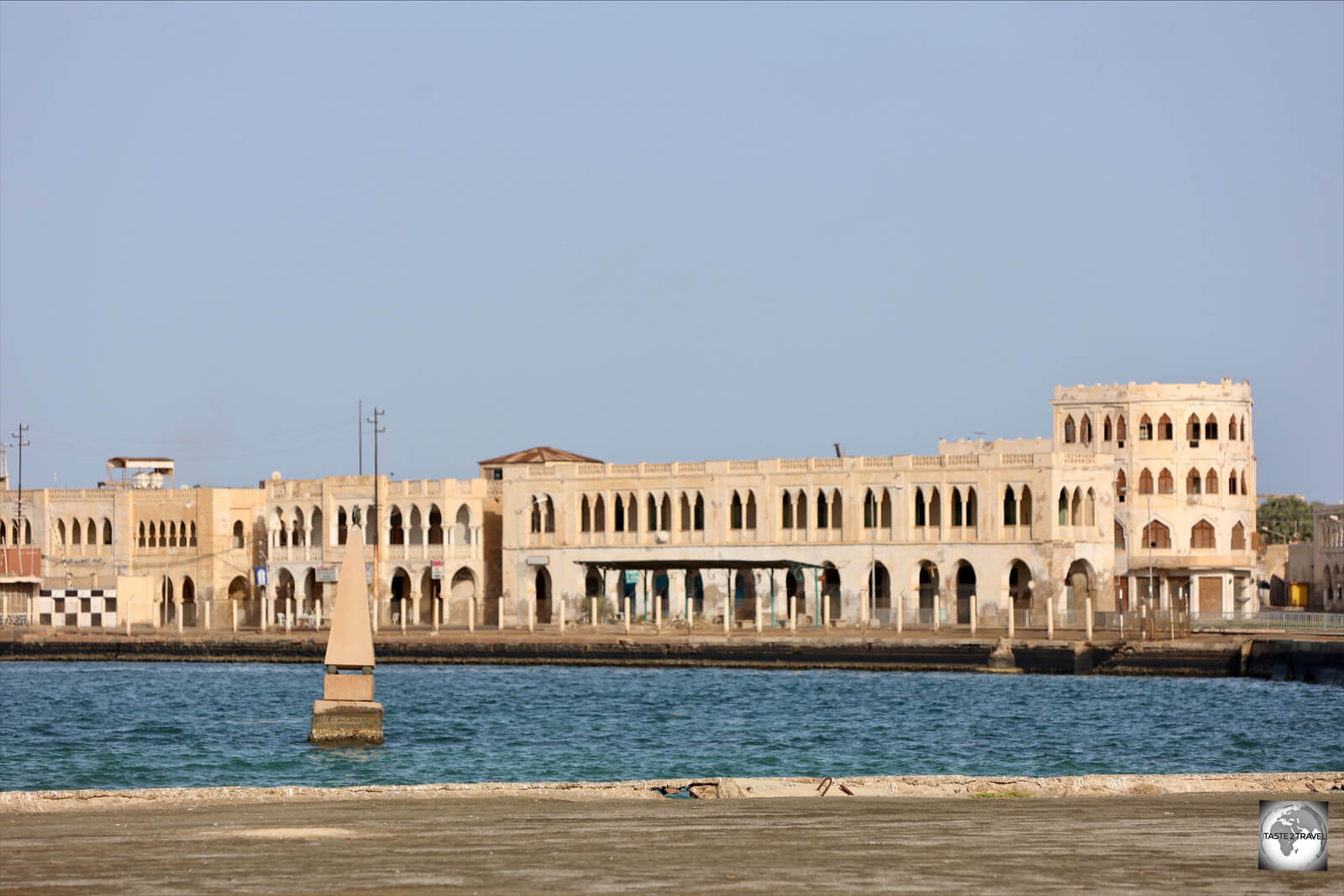
Over the centuries, the different occupiers of the port city of Massawa have left their mark in the form of architectural influences.
Eritrea extends about 1,000 km (600 mi) along the Red Sea coast and includes the islands of the Dahlak Archipelago. Due to its strategic location, Eritrea has a long history of invasion and occupation by such powers as Turkey, Egypt, Italy and Ethiopia.
Eritrea’s coastal location has long been important in its history and culture—a fact reflected in its name, which is an Italianised version of Mare Erythraeum, Latin for “Red Sea.”

A view of the central highlands of Eritrea.
While the coastal plain is extremely hot and dry, the interior of Eritrea is dominated by a high central plateau that varies from 1,800 to 3,000 metres (5,906–9,843 ft) above sea level.
The capital city, Asmara, is located at a lofty 2,325 metres (7,628 feet), making it one of the highest capital cities in Africa.
Further inland, close to the Ethiopian border, the Debub region is home to a high plateau, which drops abruptly, into the depths of the Great Rift Valley.
People

School boys in Asmara.
Eritrea’s diverse population of 3.6 million is a melting pot of different cultures and traditions. The Tigrinya, Tigre, Saho, and smaller ethnic groups each have their unique customs and traditions, which contribute to the country’s rich heritage.
Despite their differences, the people of Eritrea share a common history and are united in their love for their country.
Eritreans are very friendly and welcoming and go out of their way to make visitors feel welcome.

Printed on very thin paper, the “Eritrea Profile” is the English-language daily newspaper.
With a very low crime rate, Eritrea is a very safe country to travel in and, at no stage, did I feel threatened or hassled. Compared to other African countries, travelling in Eritrea is very relaxed.

An Eritrean Orthodox Christian.
The two major religions in Eritrea are Christianity (Eritrean Orthodox) and Islam (Sunni).
However, the number of adherents of each faith is subject to debate. Estimates of the Christian share of the population range from 47% and 63%, while estimates of the Muslim share of the population range from 37% to 52%.

Eritrean Orthodox church service at the St. Mariam church in Massawa.
Either way, the two groups live together in harmony with mosques and churches located close to each other in most towns.

Christian and Muslim friends, together in the city of Keren.
The Tigrinya ethnic group comprises the largest portion of Eritrea’s population, accounting for around 50% of the total.

Street scene in the city of Keren.
The Tigrinya people mainly inhabit the highlands, including the capital city, Asmara. They speak Tigrinya, which is also the country’s official language.

Traditional Eritrean bridal dresses, in a shop in Keren.
The Tigrinya have a rich cultural heritage, which includes music, dance, and traditional cuisine. The Tigrinya people are known for their hospitality and are often referred to as “the people of the land of harmony.”

Traditional round huts which belong to the Bilan people, who live in the vicinity of Keren.
The Tigre people are the second-largest ethnic group in Eritrea, comprising around 30% of the total population. They mainly inhabit the lowlands and coastal areas of the country.
The Tigre people speak Tigre, a language closely related to Tigrinya. They have a rich history and culture, which includes traditional dances like the Habesha, a sword dance.

Camels are often used for transporting goods in Eritrea.
The Tigre people are known for their resilience and bravery and have played a crucial role in Eritrea’s struggle for independence.
Flag

The flag of Eritrea is dominated by a red isosceles triangle based on the hoist-side pointed toward the fly-side.
The flag is further divided by two opposing triangles – an upper triangle which is green and a lower triangle which is blue.
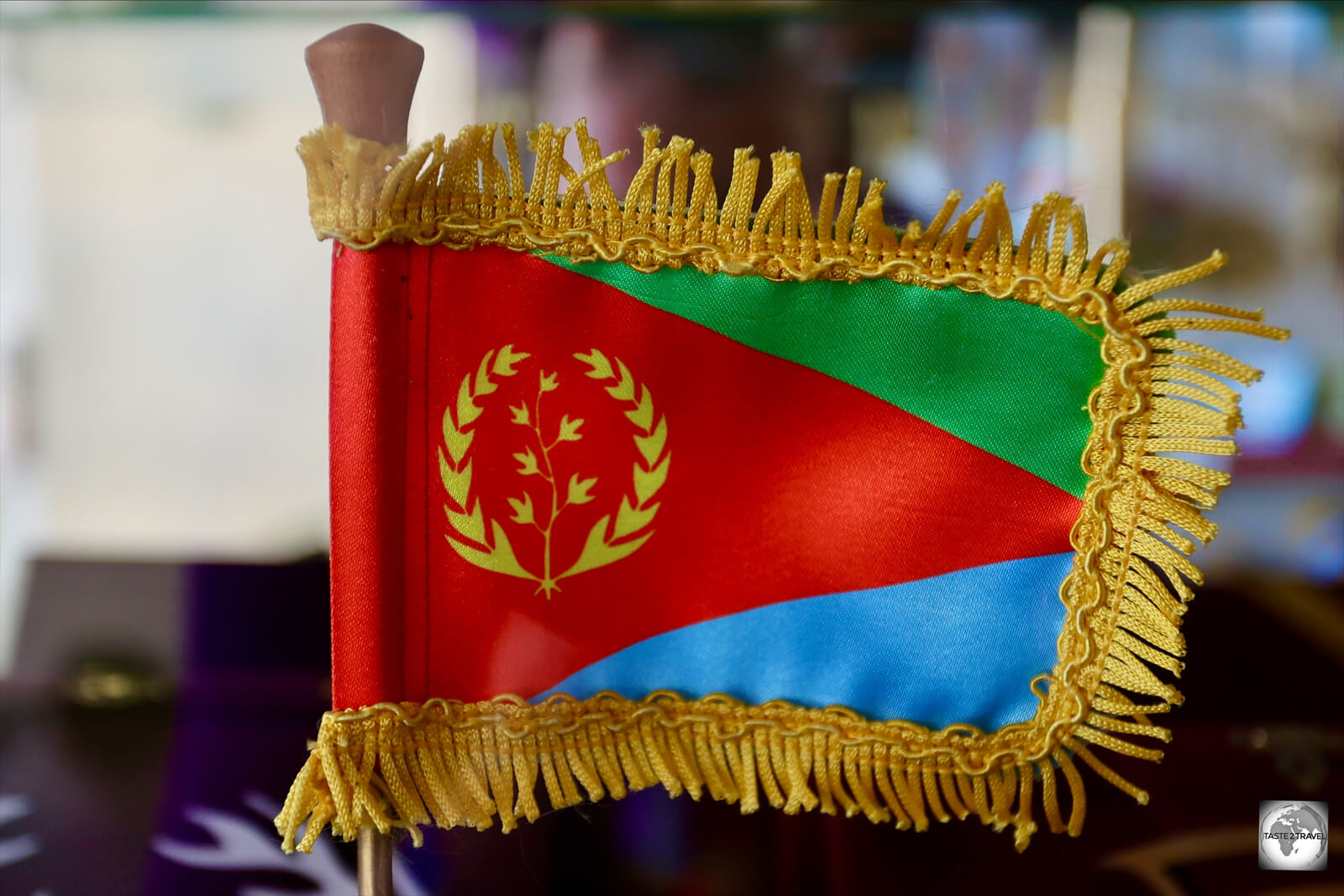
An Eritrean flag, in a gift shop in Asmara.
On the hoist-side, in the centre of the red triangle, is a yellow olive branch encircled by an olive wreath. The wreath features 30 leaves which represent the thirty years spent in the struggle for independence.

The Eritrean flag, flying alongside the flag of the Eritrean People’s Liberation Front in the city of Keren.
The red colour signifies the blood shed in the struggle for independence, while the green represents the agriculture and livestock of the country and the blue for the bounty of the sea.

The Eritrean flag, featured on a souvenir cap, at a gift shop in Asmara.
Currency

A rare find in Eritrea – a fresh, clean bank note.
The official currency of Eritrea is the nakfa which has the international currency code of ERN.
The nakfa was introduced in 1997 to replace the Ethiopian birr as the national currency. The currency is named after the town of Nakfa, which was a major centre of the Eritrean struggle for independence.

The obverse side of the 10 nakfa bank note features a scene from the now defunct Asmara to Massawa railway.
For the uninitiated, nakfa bank notes are hard to distinguish since they are all the same colour, almost the same size and feature a very similar design. Most notes are old, dirty and crumpled with notes in good condition being very hard to find.
Issued by the Bank of Eritrea, the nakfa is available in the form of coins and banknotes with 1 nakfa being divided into 100 cents. The coins are available in denominations of 1, 5, 10, 25, and 50 cents, and the banknotes are available in denominations of 1, 5, 10, 20, 50, and 100 nakfa.

Eritrean nakfa banknotes are the same colour, almost the same size and feature a similar design.
Exchange Rate:
To check the current exchange rate between USD and ERN, click on the following link:
Money Matters
Important:
Credit cards are not accepted anywhere in Eritrea! As such, credit cards cannot be used to withdraw cash at ATMs, or from a bank branch in the form of a cash advance.
Furthermore, ATMs do not exist in Eritrea and plastic cards are not in use in Eritrea.
Eritrea is purely a cash society!
It is essential that you arrive with enough USD cash to cover all your travel expenses!
You are unable to purchase any foreign currency from the few money changers which exist in Eritrea.
Being a closed economy, the currency of Eritrea cannot be exchanged outside of Eritrea. You will also not be able to convert any remaining nakfa back into USD upon your departure.

My guide, Yehdego, entering the The Himbol currency exchange shop on Harnet street, downtown Asmara.
The best place to change foreign currency is at the Himbol currency exchange which is located on Harnet street in downtown Asmara. They accept a variety of foreign currencies, but USD is preferred.
Costs
Travel costs in Eritrea are quite reasonable, with the biggest expense for me being the cost of a tour. If you travel independently, Eritrea could be a travel bargain.
Sample costs
- Room at the Asmara Palace Hotel (including breakfast): US$120 per night.
- Meal (budget restaurant): US$5 – 10
- Meal (mid-range restaurant): US$15 – 20
- Asmara Beer (always served in a brown bottle without any label): US$2
- Cappuccino: US$0.80
- Plastic bottled water (always imported): US$2.00
Wi-Fi

Unlike in most other countries, Wi-Fi is not freely available in Eritrea and its use is heavily restricted.
One local told me that the Eritrean government has observed how, around the world, the internet has been used to allow people to organise themselves to protest.
By banning the internet, almost completely, the government of Eritrea avoids such issues!
Wi-Fi Access
You can access the internet at the Asmara Palace Hotel, although it is painfully slow with a download speed of 2MBps being shared between all hotel guests.
The backbone of the hotel’s technology infrastructure is an old-style ADSL router. Very slow and almost unusable! During my time at the hotel, I was unable to view websites or even open emails.
There are a few internet cafes in most towns where you can pay to access the internet.
Tour Companies

I travelled to Eritrea with Damera tours, who I would highly recommend.

The owner of Damera Tours, Captain Kahsai, worked for most of his career as a pilot for Ethiopian Airlines.
Damera tours is owned by the friendly, enthusiastic, and wholly reliable, Captain Kahsai, a distinguished, professional, Eritrean, who worked for most of his career as a captain with Ethiopian Airlines.

Artwork, showcasing the iconic buildings of Asmara, adorns the office wall at Damera Tours.
After retiring from his aviation career, Captain Kahsai returned home to his beloved Eritrea, leaving his family and friends behind in Germany, to establish Damera tours. He now spends his time commuting between Eritrea and Germany.
Thanks to the support and assistance of Captain Kahsai, I was able to gain a visa authorisation, online, in less in 10 days.

The office of Damera Tours in Asmara.
Captain Kahsai is the proud owner of a classic, 1980’s era, gold-coloured Mercedes which he drives around Asmara in style! You should definitely take him up on any offer of a ride!
Contact Details for Captain Kahsai
Captain /Dr. Kahsai Berhane
CEO & Chief Pilot
Damera Aviation Plc
Phone: +291 118 1027
Fax: +291 118 2033
P.O. Box 6015
Asmara
Eritrea
E-Mail:
dameratours@gmail.com
Website:

Touring the remote Debub region, which is only accessible via 4WD, with Damera Tours.
Tour Itinerary and Costs
I booked a 6D/ 5N tour, which covered Asmara, Massawa, Keren and the ruins of Qohaito.
As a single passenger, the tour cost me a total of US$1490. The cost for 2 or more travellers is US$990 per person.
Tour Inclusions
Included in the cost of the tour was visa service, transport, driver, guide and accommodation – with most nights spent at the very comfortable Asmara Palace Hotel – the best hotel in Eritrea!
My guide, Yihdego Bairu, was highly knowledgeable, very patient (while waiting for me to finish taking my many photos), and seemed to have friends in every corner of Eritrea. He repeatedly told me that having me as a client wasn’t work – it was a pleasure! So kind!
My driver, Michael, was very competent and seemed to have knowledge of every pot hole in the road, which he always managed to avoid.

On the road from Asmara to Massawa with Damera Tours.
Tour Exclusions
What wasn’t included in the cost of the tour were personal expenses, meals, drinks and the visa fee of US$70.
Meals are not necessarily cheap in Eritrea, with an average meal (with a drink) costing between US$15 – 20.

A spectacular view of the Great Rift Valley, which I visited in a 4WD, with the amazing team from Damera Tours.
Visa Service
As part of their service, Damera tours takes care of securing visas for their clients. More details on this, plus an outline of the visa process, can be found in the Visa Requirements section below.
Fauna

A staring competition with a male hamadryas baboon.
A common sight on the side of the highways in Eritrea are troops of hamadryas baboons.
Always looking for a free feed, these baboons are the northernmost of all the baboons, being native to the Horn of Africa and the southwestern region of the Arabian Peninsula.
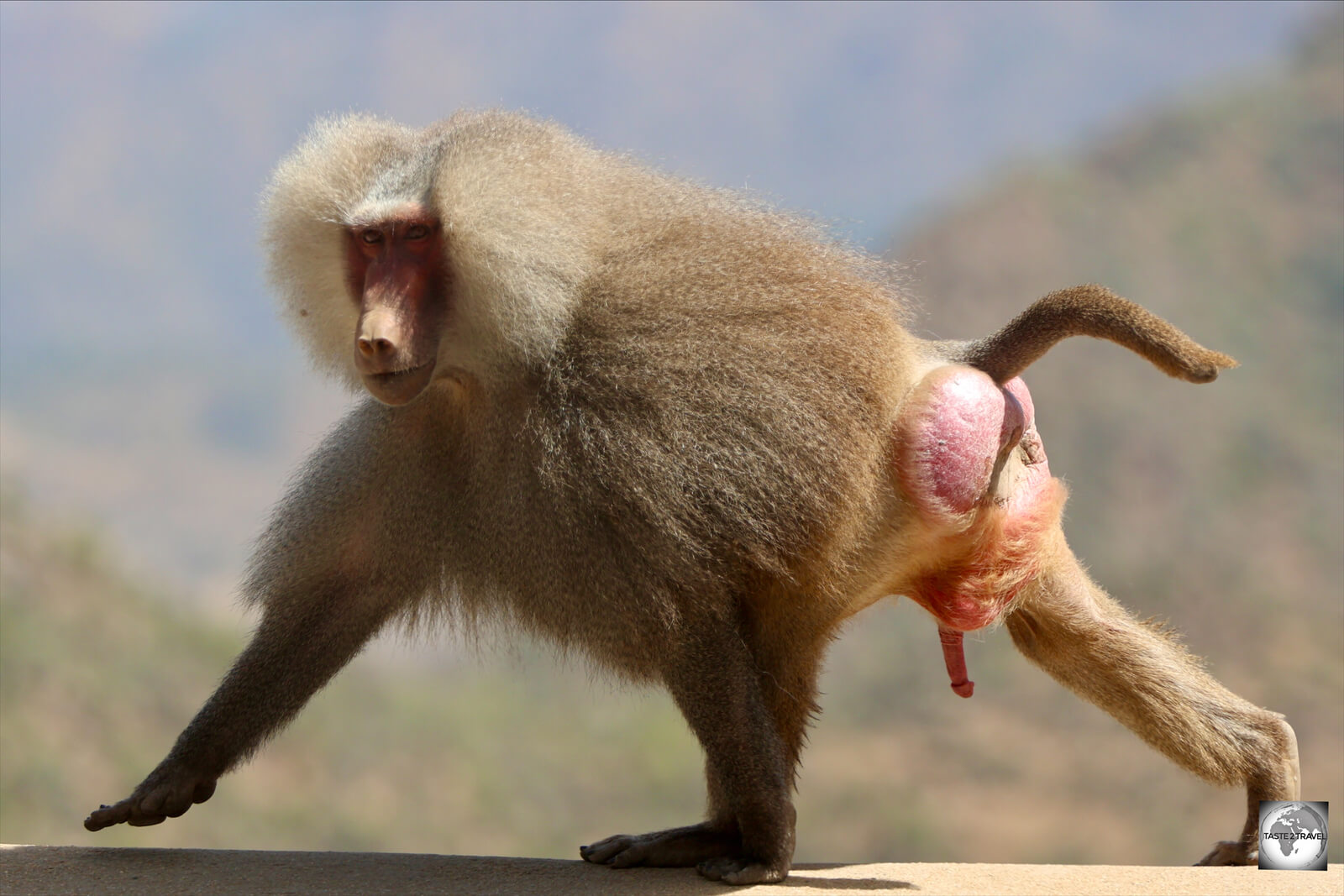
A male hamadryas baboon.
These regions provide habitats with the advantage for this species of fewer natural predators than central or southern Africa where other baboons reside.

A much smaller female hamadryas baboon with her infant.
One of the more striking features of this species of baboon is its sexual dimorphism – males are nearly twice as large as females.
Adult males have a pronounced cape (mane and mantle), silver-white in colour, which they develop around the age of ten, while the females are cape-less and brown all over.
Sightseeing
During my 6 days in Eritrea, I visited the following locations:
Asmara

A view of Harnet street, the main street of Asmara, with Asmara cathedral in the background.
Wonderful, charming and inviting! That is Asmara!
Home to 970,000 souls, Asmara is the capital city of Eritrea, located in the central highlands of the country. The city has a rich history and a unique blend of architectural styles, reflecting the diverse cultural influences that have shaped its development over the centuries.

The iconic, Cinema Impero, is one of many Italian-built art-deco cinemas to be found in Asmara.
Asmara was founded in the late 19th century as a small village, but it quickly grew into a bustling centre of commerce and trade.
The city was occupied by Italy in the early 20th century, and it was during this period that many of its most iconic buildings were constructed, including the Art Deco Cinema Impero, the Futurist Fiat Tagliero building, and the Romanesque-style Asmara Cathedral.

Wrecked plane engines in the Tank Graveyard in Asmara.
During the Italian colonial era, Africans tourists from surrounding countries would visit Asmara to shop in its many Italian boutiques and to wine and dine in its many Italian restaurants. The city offered a slice of ‘Bella Roma’ in the Horn of Africa.
One of the highlights of Asmara is its unique architecture, which is a blend of Italian, Art Deco, and modernist styles. The city’s buildings, which are listed as a UNESCO World Heritage Site, are known for their colourful facades, ornate balconies and intricate details.
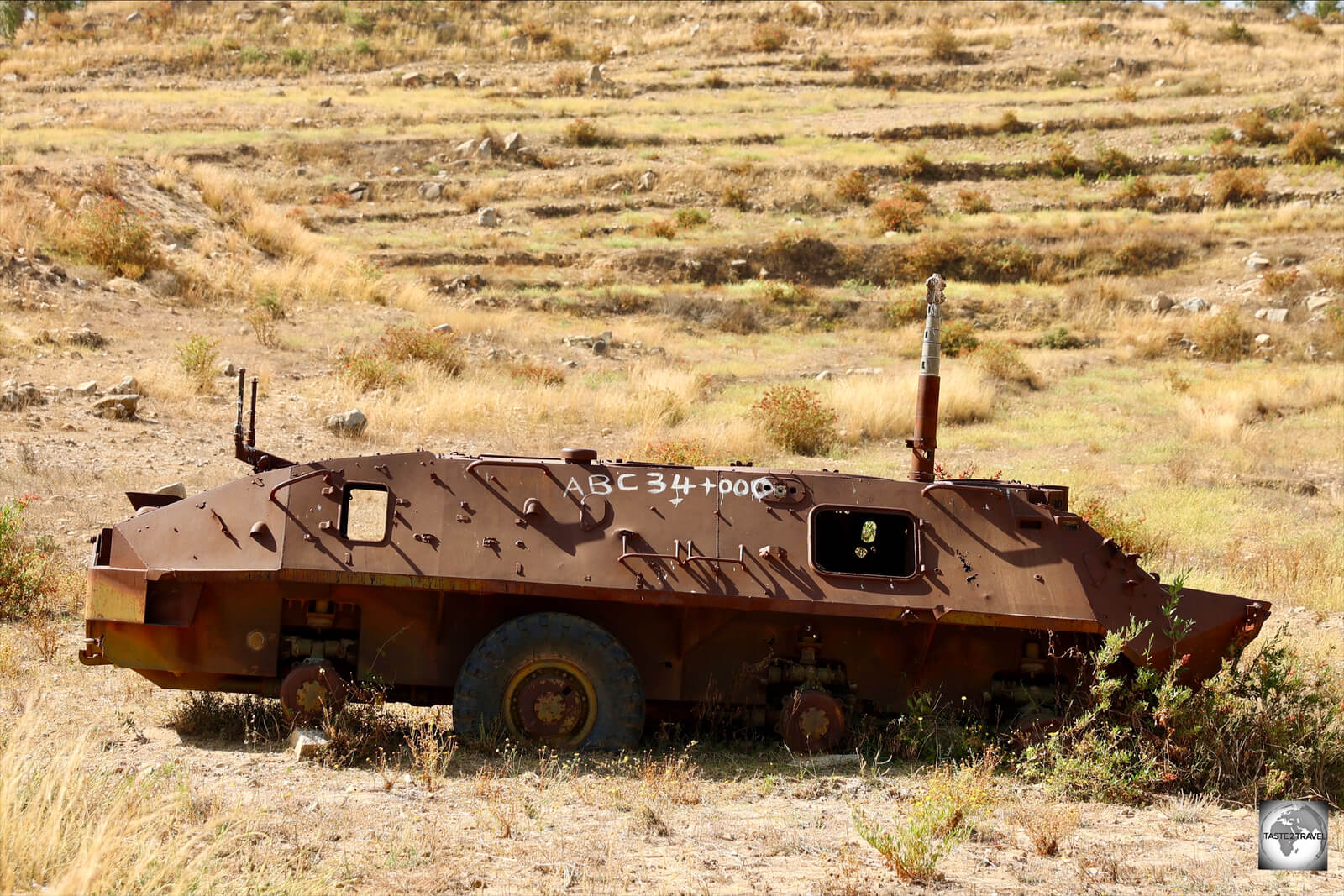
A wrecked tank on the side of the highway outside Asmara.
Overall, Asmara is a charming and fascinating city that offers a unique blend of history, culture, and architecture. An elderly Italian tourist commented to me that the city reminded him of Rome in the 1950’s.
Asmara Tank Graveyard

The tank graveyard in Asmara is home to 1000’s of pieces of destroyed military equipment.
The Tank Graveyard in Asmara is a site located on the outskirts of the city that contains 1000’s of destroyed and abandoned military tanks, armored vehicles, and other war machines.
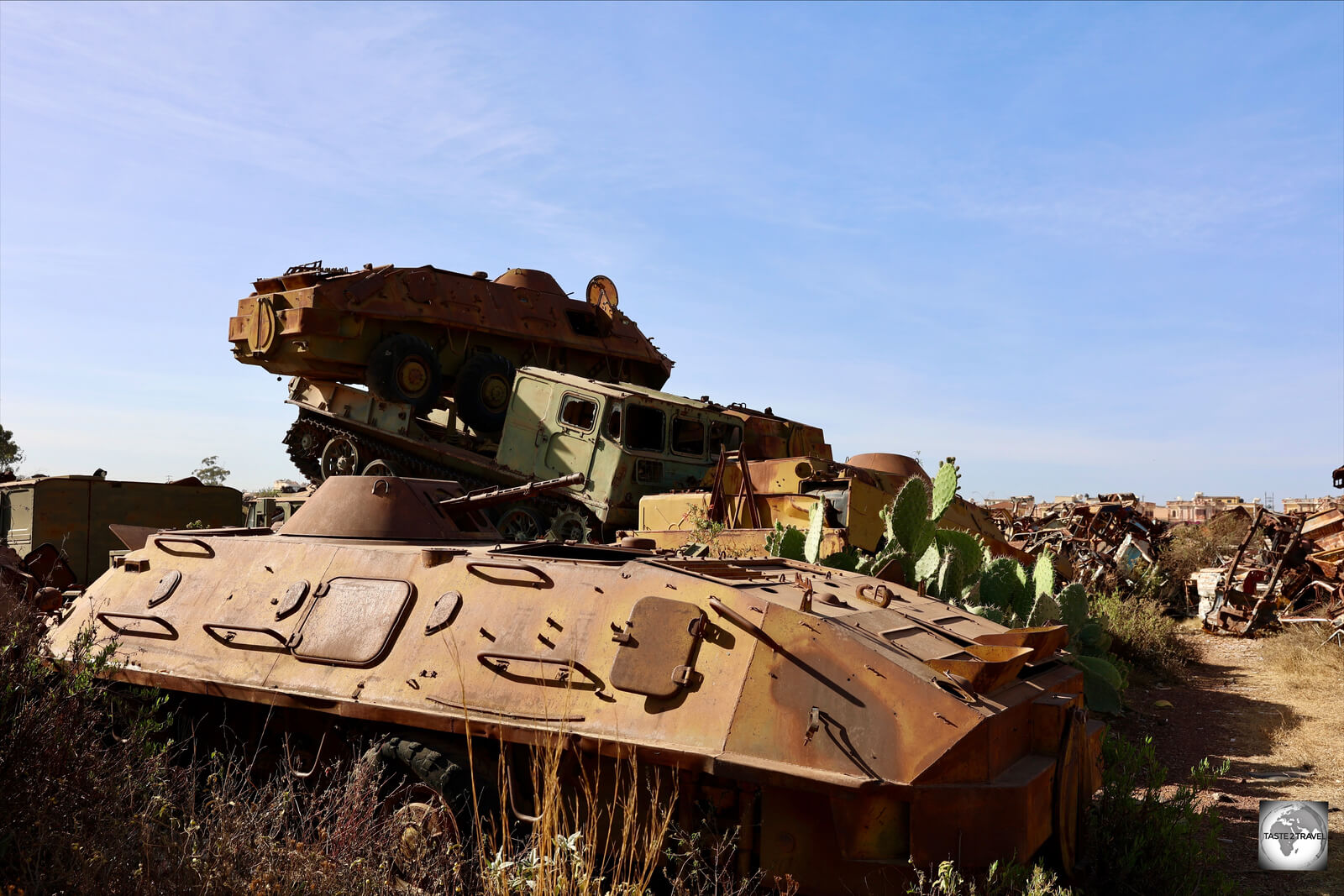
Destroyed tanks, stacked on top of each other, in the Tank Graveyard in Asmara.
The tanks are remnants of the Eritrean War of Independence, which was fought between Eritrean rebels and Ethiopian forces from 1961 to 1991.
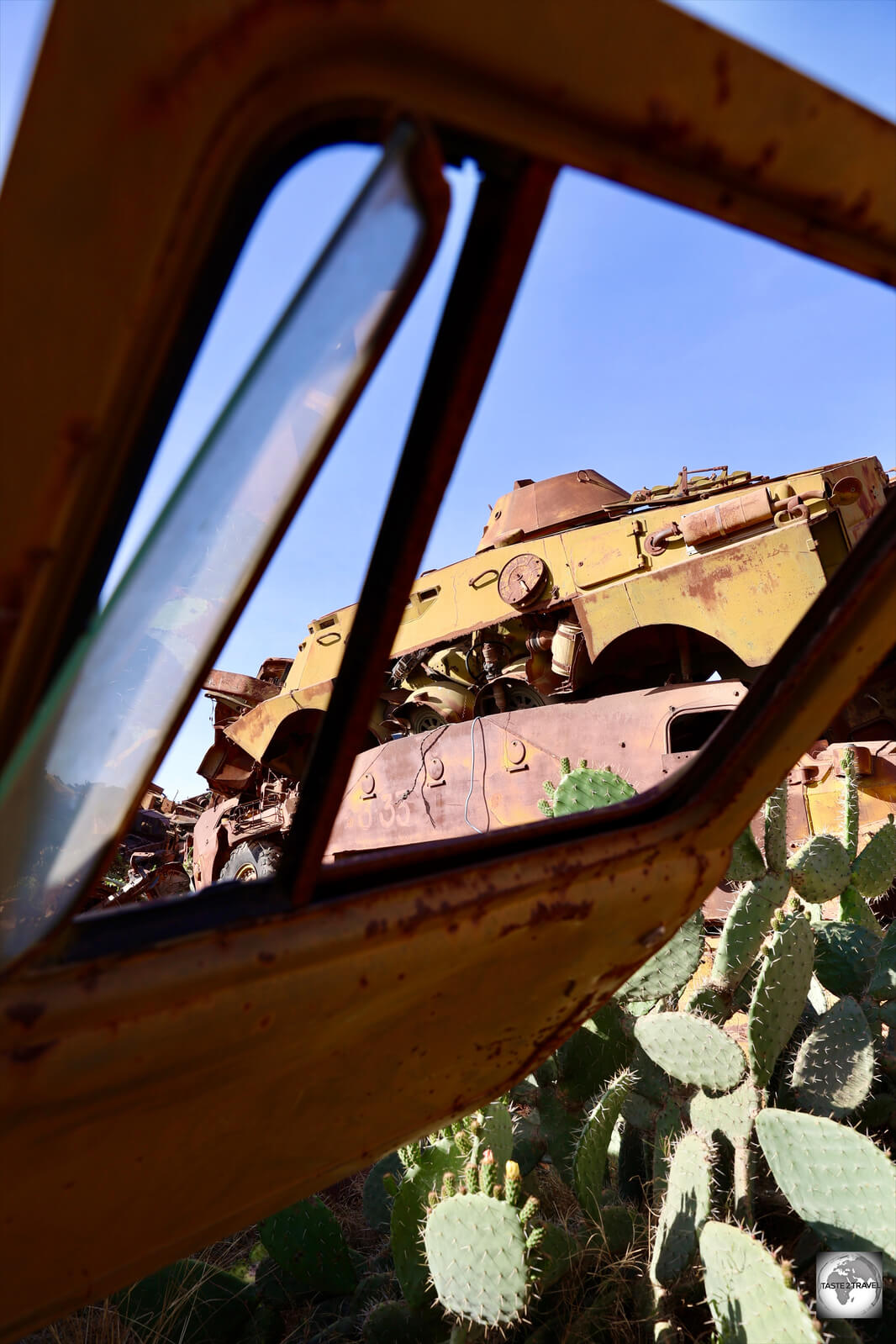
The Tank Graveyard is home to a colossal collection of destroyed military equipment.
The Tank Graveyard is an eerie and desolate place, with rusting tanks scattered across a barren landscape.
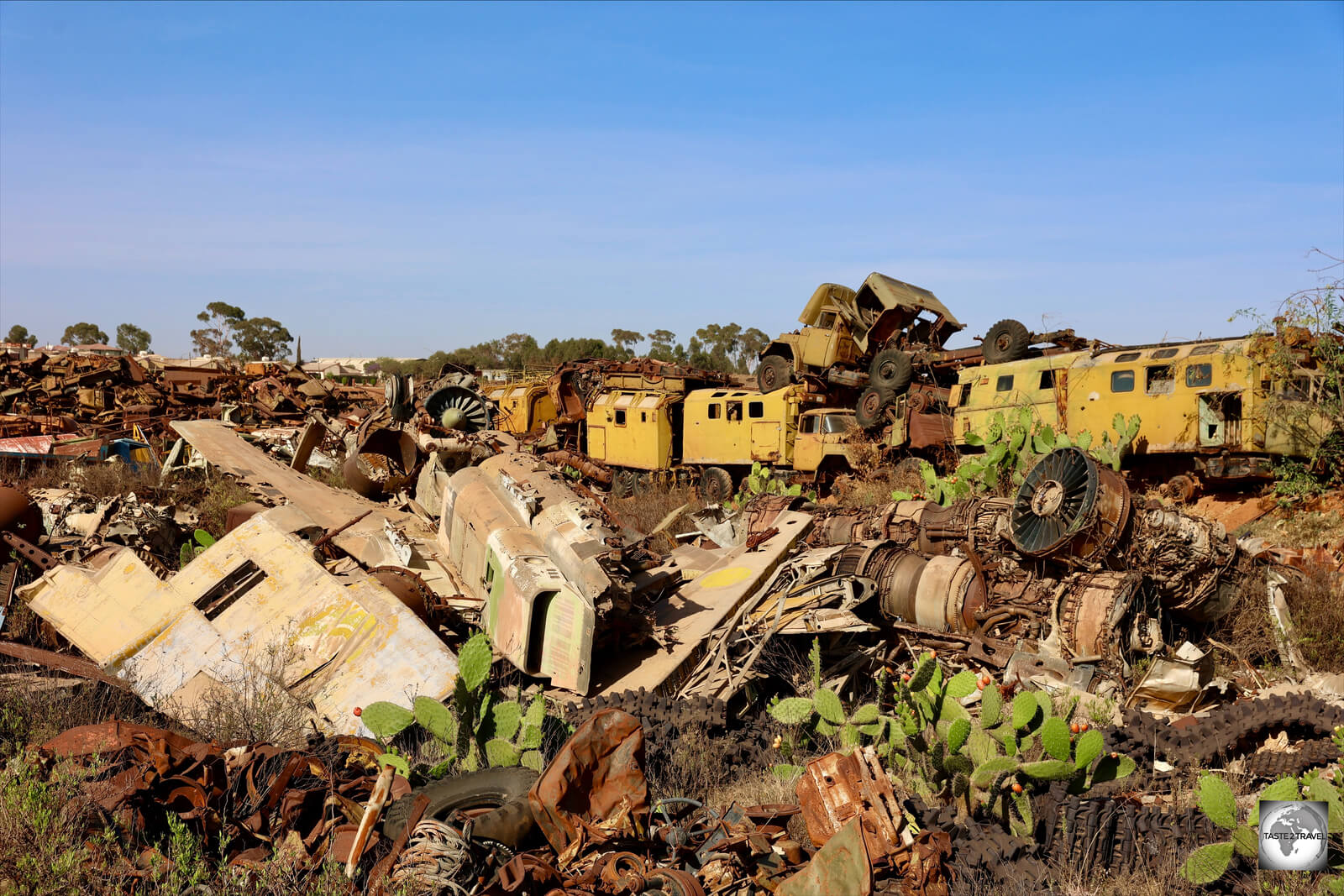
Besides tanks, there are many wrecked planes in the graveyard.
Many of the tanks are heavily damaged or have been stripped of parts, and the site is a haunting reminder of the violence and destruction that occurred during the war.

Wrecks upon wrecks at the Tank Graveyard in Asmara.
Despite its grim appearance, the Tank Graveyard is a fascinating sight – one of my favourite sights to photograph in Eritrea.

When will mankind learn that there are no winners from war?
It also serves as a reminder that there are no winners in war!

A haunting and eerie sight – the Tank Graveyard in Asmara.
Fiat Tagliero Building

Designed by the Italian architect Giuseppe Pettazzi in 1938, the Fiat Tagliero Building is considered one of the most important examples of Futurist architecture in the world.
The Fiat Tagliero Building is an iconic landmark located in downtown Asmara.
A truly impressive sight (love those unsupported, cantilevered wings), it was designed by the Italian architect Giuseppe Pettazzi in 1938 and is considered one of the most important examples of Futurist architecture in the world.

The Fiat Tagliero Building was originally built as a petrol station and car service centre for the Italian car manufacturer Fiat.
The building is characterized by its striking shape, which resembles an airplane with its wings spread.
The central portion of the building houses an impressive cantilevered roof that extends 15 metres without any visible supports. This feature gives the building a sense of weightlessness and creates an impression of movement and speed.
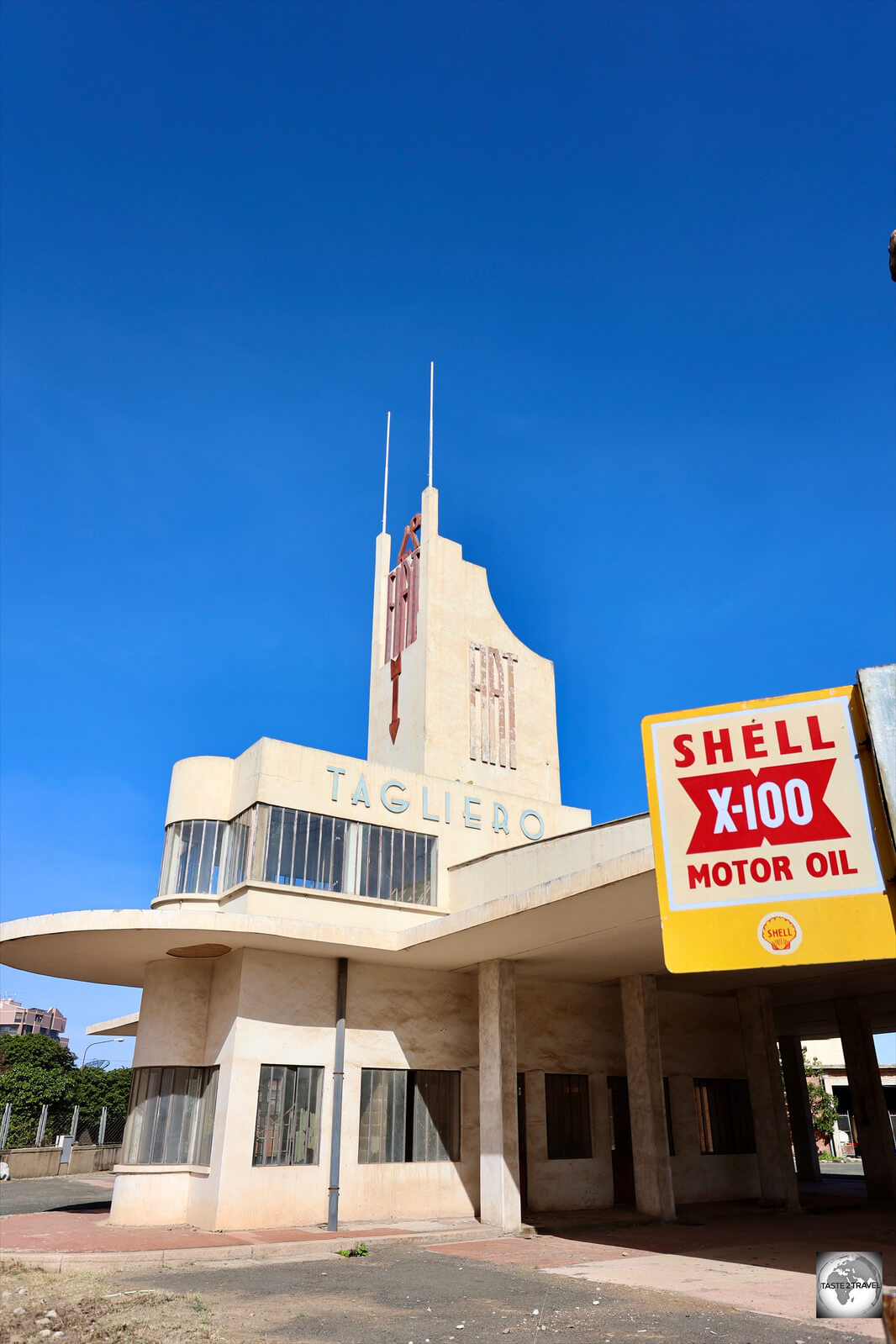
The Fiat Tagliero Building in Asmara.
The Fiat Tagliero Building was originally built as a petrol station and car service centre for the Italian car manufacturer Fiat.
It is an impressive example of Italian Rationalism, a design movement that favored simplicity, functionality, and modern materials such as reinforced concrete.

Detail of the central tower of the Fiat Tagliero Building.
The Fiat Tagliero Building is a testament to the vision and creativity of Giuseppe Pettazzi and serves as a reminder of Asmara’s unique architectural legacy – a legacy which has resulted in the city’s iconic buildings being listed as a UNESCO World Heritage Site.
Asmara Cathedral

The Italian-built Asmara cathedral was constructed in the 1920’s and is considered to be one of the finest Lombard/ Romanesque style churches outside Italy.
Asmara Cathedral, also known as the Cathedral of Our Lady of the Rosary, is a Catholic cathedral located in downtown Asmara.
It is considered to be one of the most important religious and architectural landmarks in Eritrea.

A view of the roof and belltower of Asmara cathedral.
The Cathedral was constructed from 1921 to September 1923 and was inaugurated in 1923, and is thought to be one of the finest Lombard/ Romanesque style churches outside Italy.

A view of the interior of Asmara cathedral.
The cathedral is an impressive example of Italian colonial architecture, blending Romanesque and Baroque styles with traditional African elements.
The interior of the cathedral features marble floors, stained glass windows, and ornate altars.

A view of the central dome of Asmara cathedral.
Cinema Roma
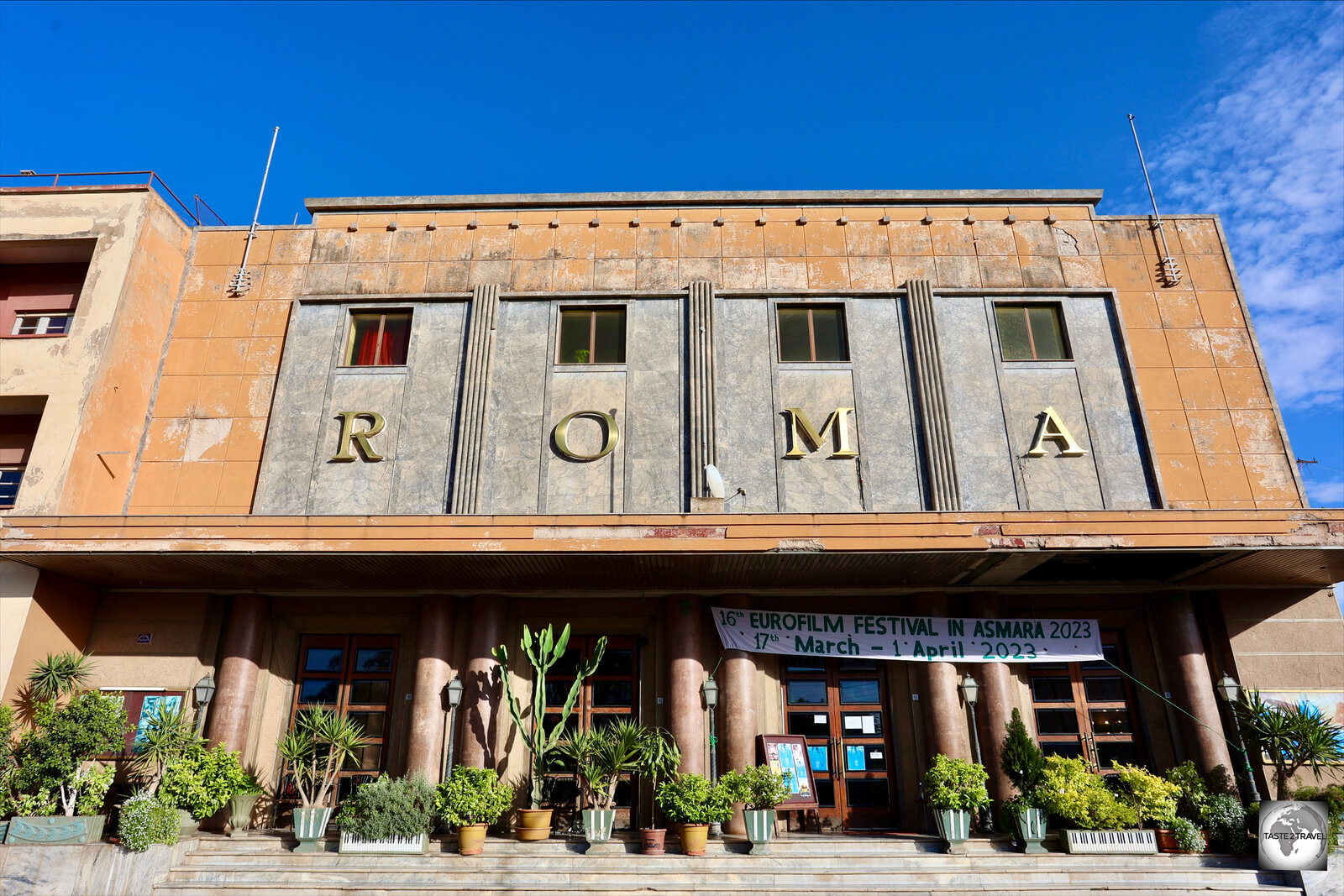
The Italian-built, 1930’s-era, Cinema Roma is considered one of the most significant examples of Art Deco architecture in Eritrea.
Cinema Roma is an historic cinema located in downtown Asmara.
It was built during the Italian colonial period in the early 1930s and is considered one of the most significant examples of Art Deco architecture in the country.

During the time of my visit, Cinema Roma was hosting a Euro Film festival.
The cinema was designed by the Italian architect Mario Messina and features a distinctive façade that is typical of the Art Deco style.

The lobby of the Cinema Roma in Asmara.
The interior of the cinema is equally impressive, with a spacious auditorium that can seat over 1,200 people, as well as a balcony and a VIP area.

The plush-red auditorium provides seating for 1,200 people.
Cinema staff granted me special access to the upstairs balcony, and VIP room, so that I could take photos of the entire auditorium.
My guide commented, that I must be a VIP since it was the first time ever that he had been granted access to the balcony!
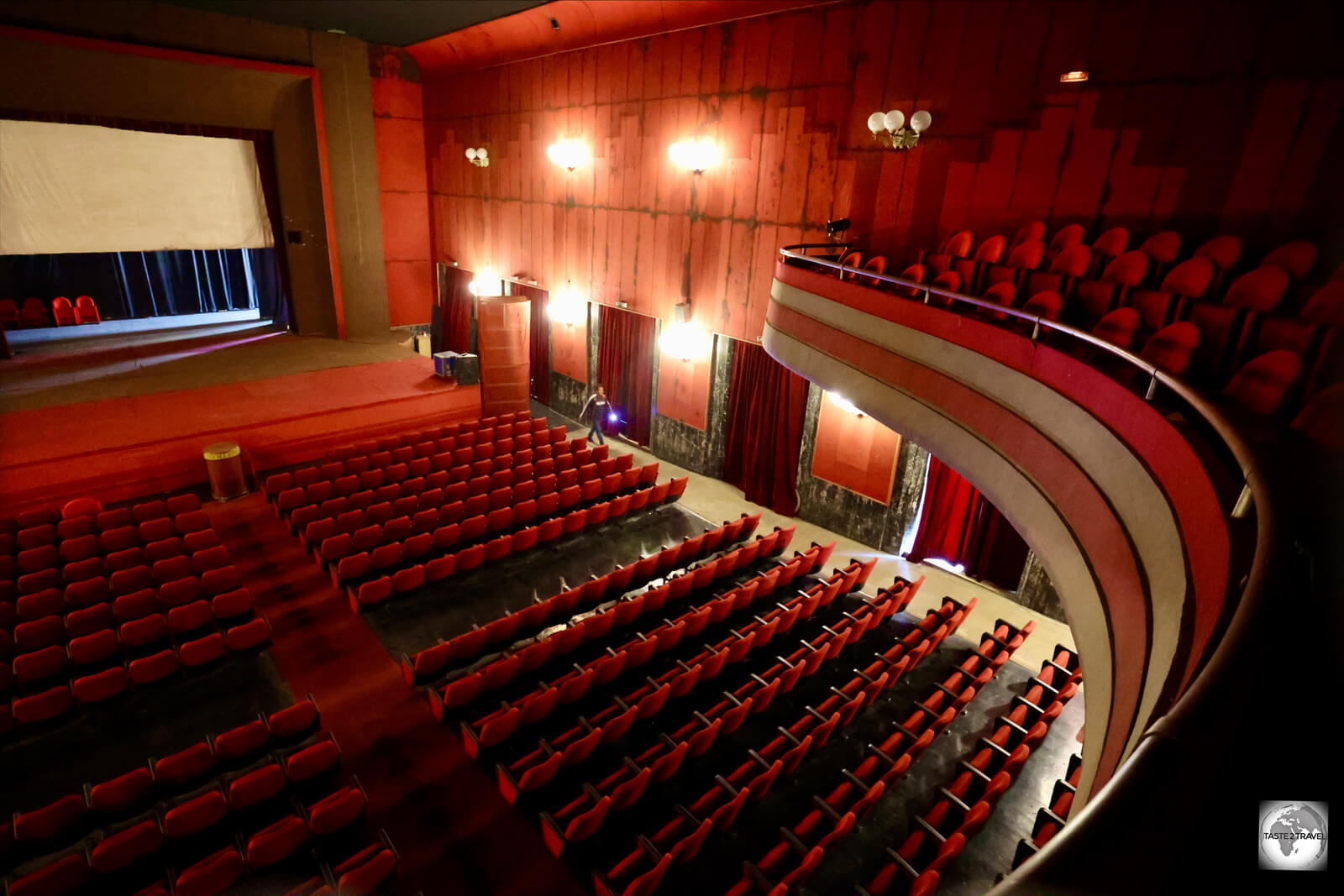
I was granted special access to take photos of the auditorium from the upstairs balcony.
Cinema Roma was once a thriving entertainment venue and played an important role in the cultural life of Asmara.
It screened a wide range of films, including Italian, American, and local productions, and was a popular destination for moviegoers from across the city.
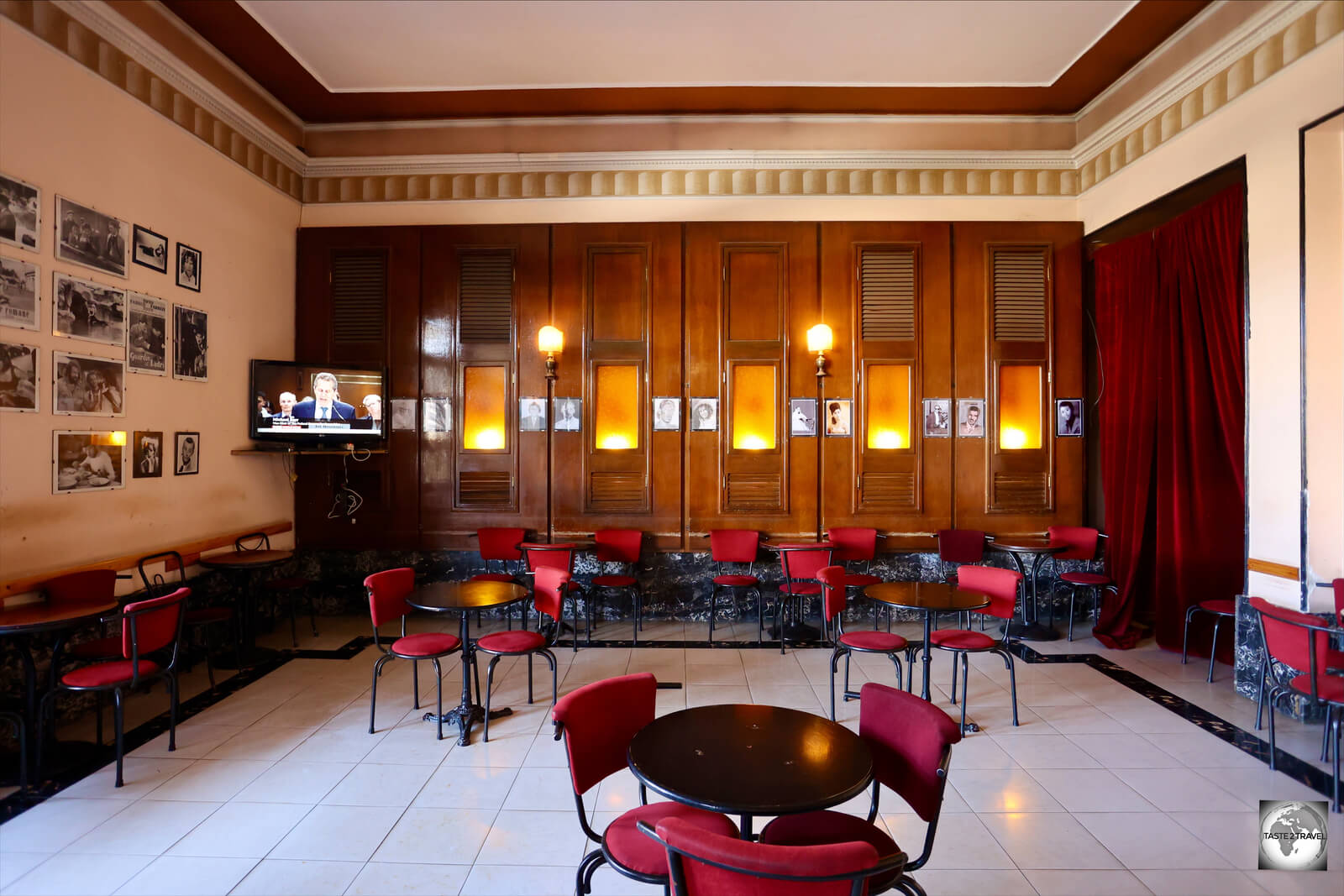
A view of the beautiful café, that graces the lobby of Cinema Roma in Asmara.
Over the years, the cinema hosted a number of special events, such as premieres and film festivals, and even served as a venue for political meetings and rallies.
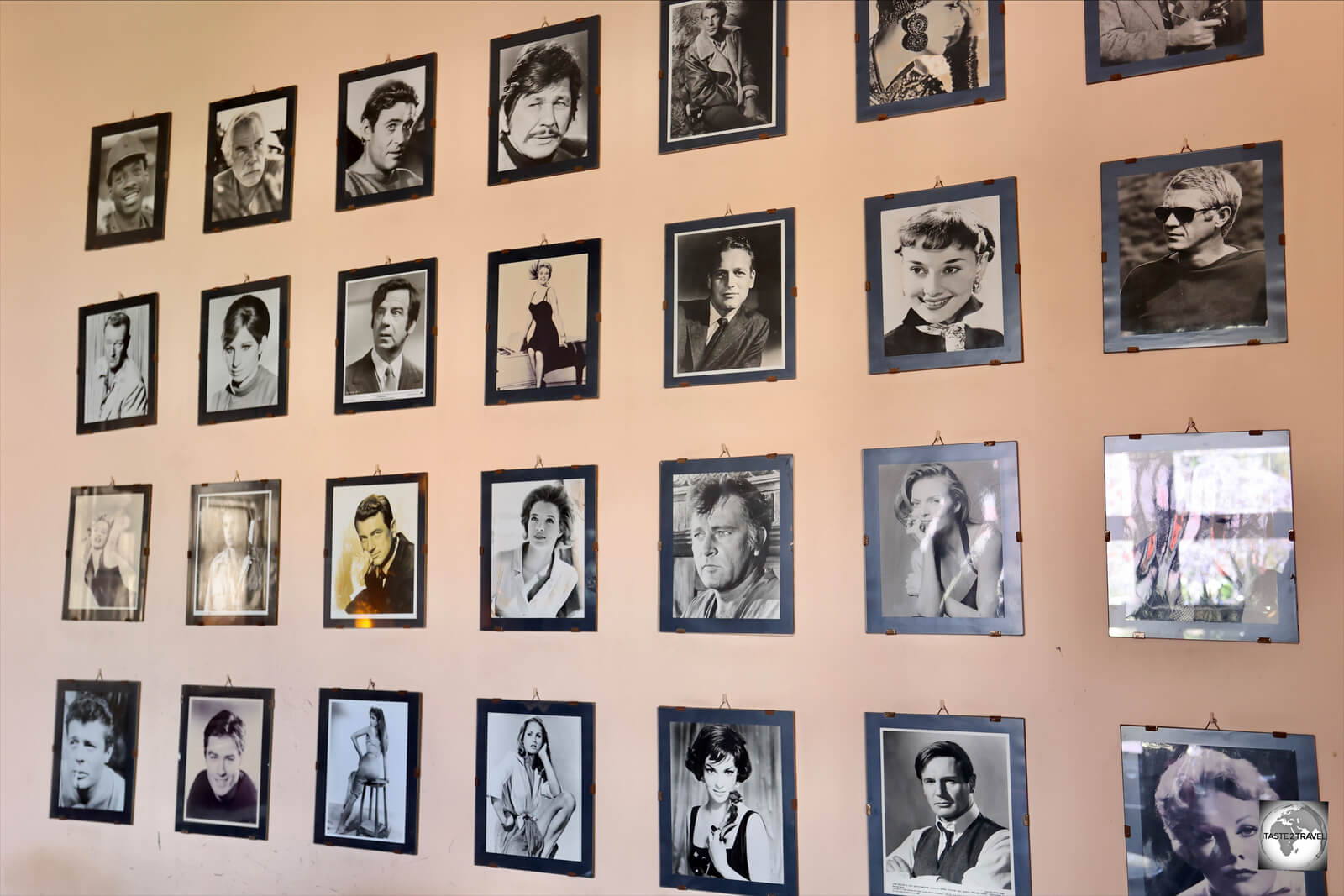
Photos of legendary stars line the walls of Cinema Roma.
Today, Cinema Roma stands as a symbol of Asmara’s rich cultural heritage and is considered a national treasure. It was a joy to be able to photograph such a beautiful building.

The lobby of Cinema Roma.
Bar Zili

Said to resemble an old-style radio, the Art-deco Bar Zilli was built during the late stages of Italian colonial rule.
Another iconic art-deco building is Bar Zilli which was built during the final days of Italian rule. It has been suggested by some that the building resembles an old-fashioned radio set, with windows like tuning buttons.
Asmara Commonwealth War Cemetery

The entrance to the Asmara Commonwealth War Cemetery.
Located on the outskirts of Asmara, on the highway to Massawa, the Asmara Commonwealth War Cemetery is the final resting place for British and Commonwealth soldiers who died while fighting the Italians during WWII.

One of the most striking features of the cemetery is the Cross of Sacrifice, a tall stone cross that stands at the centre of the cemetery.
The cemetery covers an area of about 3.5 acres and contains over 400 graves, many of which are marked with simple white headstones.
I was given a comprehensive tour of the cemetery by the enthusiastic caretaker who was keen to share his knowledge of all those who are buried at the cemetery.
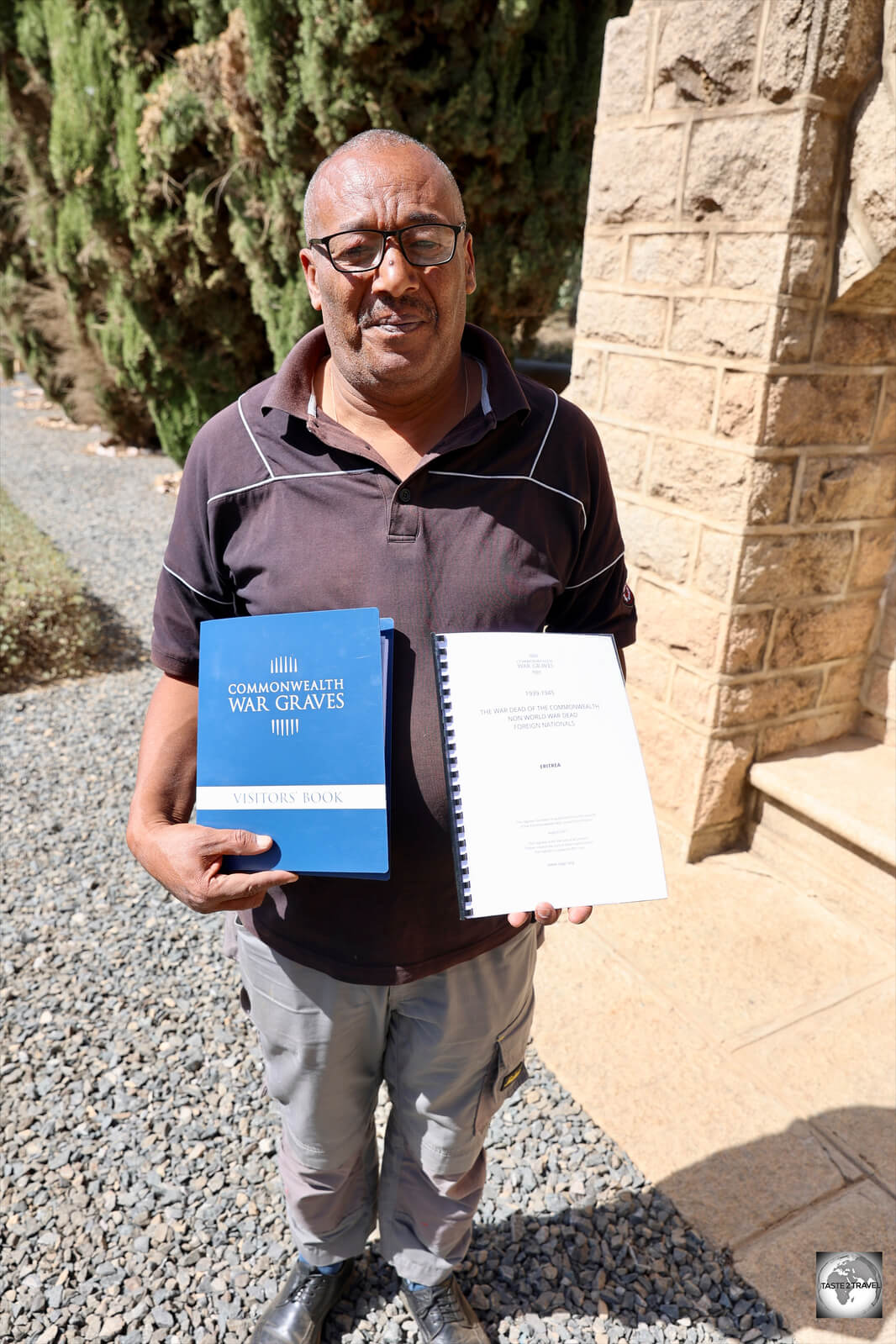
The cemetery caretaker, showing me a register of all buried soldiers.
The cemetery is maintained by the Commonwealth War Graves Commission, which ensures that the graves are kept in good condition and that the memories of those who fought and died in the service of their country are properly honoured.

A register of soldiers buried at the Asmara Commonwealth War cemetery.
The Asmara Commonwealth War Cemetery serves as a poignant reminder of the sacrifices made by the soldiers and civilians who fought and died during World War II and the period of British administration in Eritrea.
Massawa

Located in front of the former Banco d’Italia building in Massawa, this empty plinth once featured a statue of Haile Selassie.
Massawa is a port city located on the Red Sea coast of Eritrea, about 120 kilometres southeast of Asmara.

Sunset over the Red Sea port city of Massawa.
The city has a long and rich history dating back to ancient times, and it has been an important centre of trade and commerce for centuries.

Residents of Massawa old town continue to live among the remains of war-ravaged buildings.
Massawa was a major trading hub during the Axumite period, and it continued to thrive during the Islamic period, when it became an important centre of Islamic learning and culture.

Children, living among the ruined buildings in Massawa old town.
The city was also a key port of call on the trade routes between Europe, the Middle East, and Asia.

Remains of a shop in Massawa old town.
Massawa’s architecture is a testament to its long history, with buildings that reflect the diverse cultural influences that have shaped the city over the centuries.

Massawa old town is a treasure trove of different architectural styles.
The city’s narrow streets and alleyways are lined with colourful, ornate buildings that range in style from traditional African to Ottoman, Egyptian and Italian colonial.

An Ottoman-era building in Massawa old town.
The Ottomans, who first captured Massawa in 1557, tried to extend their control inland but failed.

An old St. Vincent-registered boat in Massawa port.
They instead focused their efforts on building monumental buildings around Massawa port with the intention of converting the town into a leading Red Sea trade centre.

An Ottoman-era building in Massawa.
Many fine examples of Ottoman architecture lay in ruin today, following the bombardments during the War of Independence.

A mosque in Massawa old town.
Most of the buildings of the old town have been constructed using coral stone from nearby quarries.

An ornate Ottoman-era building in Massawa old town.
Unfortunately, in 1991, Massawa was heavily bombed by the Ethiopian air force in the final days of the 30-year War of Independence.

A crumbling, neglected architectural jewel in Massawa old town.
Even after more than 30 years, most buildings in the old town remain war-ravaged, with residents living on the ground floor of homes, whose upper levels have been destroyed by bombs.

An abandoned building in Massawa old town.
With my guide Bairu, I did a walking tour of Massawa old town, visiting some of the iconic architectural gems which still lay destroyed following the bombing of the city.

Details of an abandoned building in Massawa old town.
A treasure trove of architectural gems from many different occupiers, the old town of Massawa would be an amazing sight if ever fully renovated.
Imperial Palace

The war-ravaged remains of the Imperial Palace in Massawa.
Across the road from the Grand Dahlak Hotel, overlooking the harbour, the war-ravaged Imperial Palace was built by the Turkish Osdemir Pasha in the 16th century.
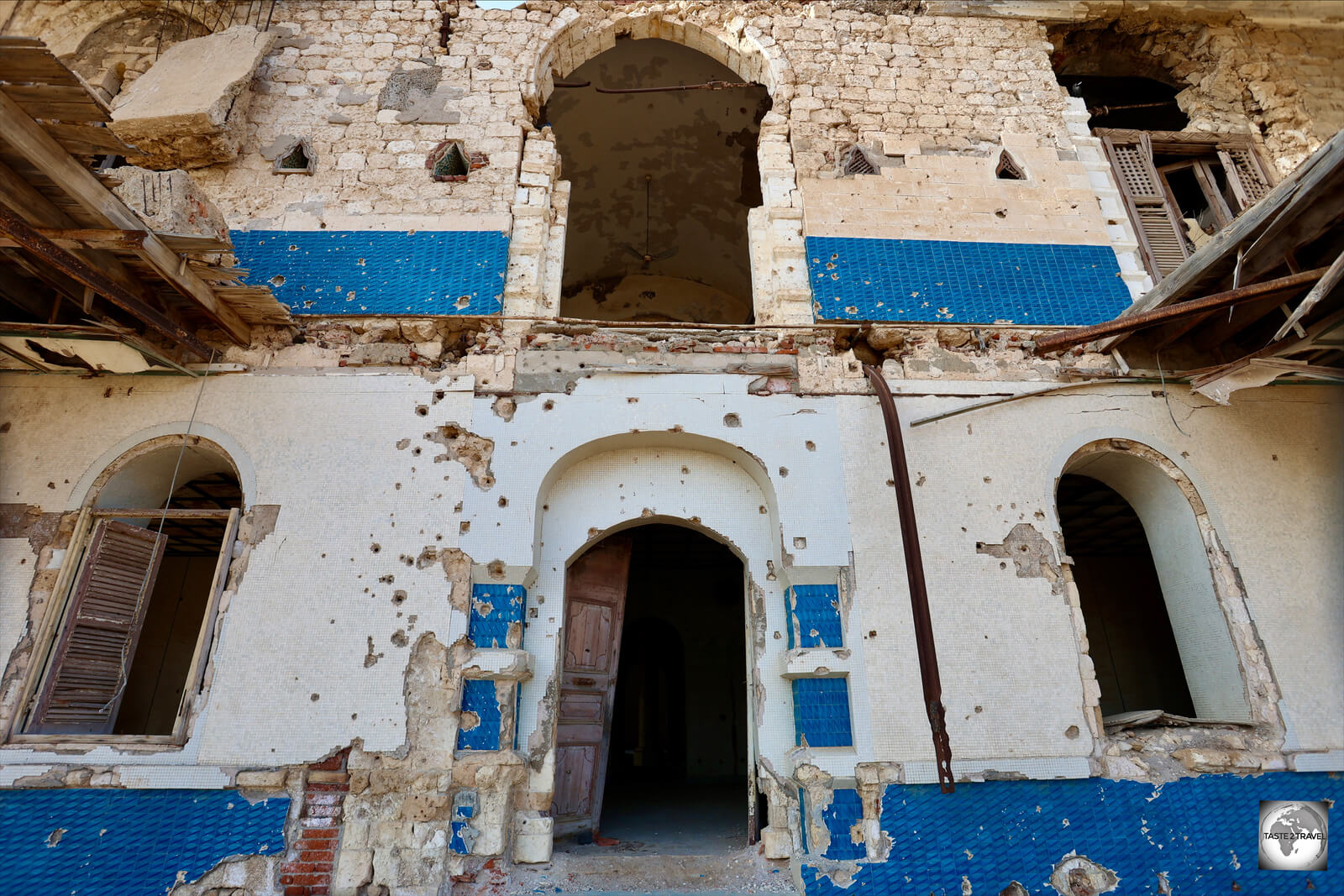
The ruins of the Imperial Palace stand at the entrance to Massawa old town.
The present building dates from 1872, when it was built for the Swiss adventurer Werner Munzinger. For any Swiss readers, Herr Munzinger was a native of Olten.
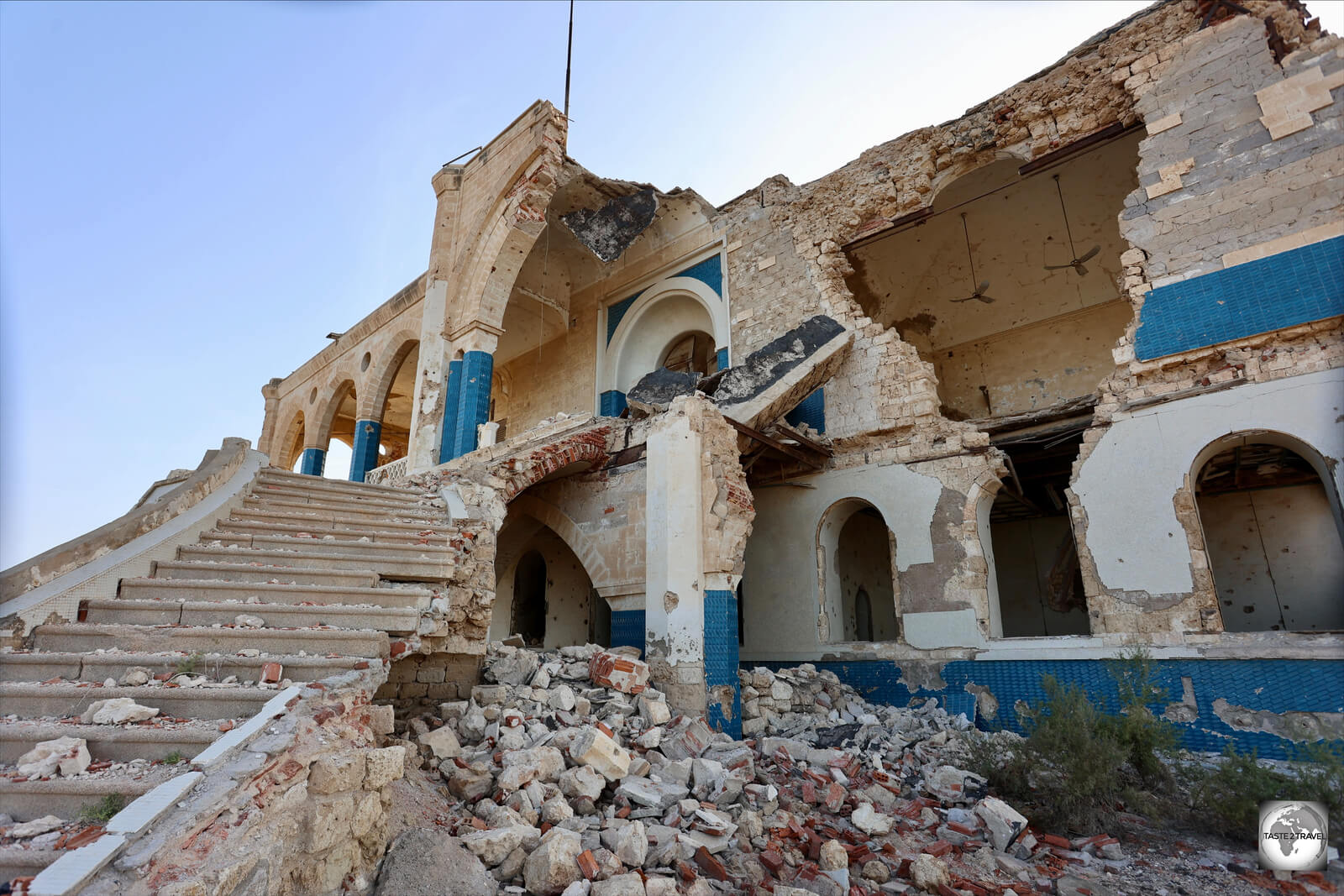
A view of the main entrance to the Imperial Palace.
During the federation with Ethiopia, the palace was used as a winter palace by Emperor Haile Selassie, whose imperial lions still stand guard at the palace entrance.

Installed during the reign of Emperor Haile Selassie, imperial lions guard the entrance to the Imperial Palace in Massawa.

A view of the interior of the Imperial Palace.
Former Banco d’Italia Building

The iconic Banca d’Italia building was originally built by the Italians in the 1920’s.
Located across from the entrance to Massawa port, the very grand and imposing Banca d’Italia (Bank of Italy) building was originally built by the Italians in the 1920’s.
For decades, it served as the largest bank under the Italian administration and was later renamed to Haile Selassie Bank under Ethiopian occupation. An empty plinth in front of the bank once featured a statue of Haile Selassie.
In 1991, in the final days of the War of Independence, the building was severely destroyed by Soviet and Ethiopian bombardments.

A view of the war-ravaged main entrance to the Banca d’Italia building in Massawa.
In 2011, a plan was unveiled to completely renovate/ rebuild this iconic building, converting it into a hotel featuring eight luxury suites. However, as of 2023, the building remains in ruin.
Tank Memorial

The Tank Memorial in Massawa, features three tanks which were used to defeat Ethiopian forces in 1990.
Located in Massawa new town, the imposing Tank War Memorial features three tanks (Tiger, Jogar, Commander) that were instrumental in the liberation of Massawa during Operation Fenkel in February 1990.
Also known as the Second Battle of Massawa, the tanks were used by Eritrean forces to block the causeway connecting Massawa to the mainland. These same forces were then able to force Ethiopian forces to retreat inland, surrendering Massawa.
Asmara-Massawa Railway

A painting, in a café in Keren, shows the Asmara to Massawa railway.
The Eritrean railway system was built by the Italian colonists who ruled the country from the end of the 19th century until the end of World War II.

One of many Italian-built stone viaducts which lie on the Asmara to Massawa rail line.
Its construction began in Autumn 1887. Originally, the colonists were planning to use the train for the purposes of moving their military personnel as well as to carry minerals from the many mines which they were exploiting all over Eritrea.
It is in 1911 that the train finally connected Asmara, the capital, to Massawa. At its peak, the system had over thirty-nine tunnels, sixty-five bridges and had trains operating on a regular daily basis.

One of many stone viaducts on the Asmara to Massawa railway.
During the War of Independence, the line was severely damaged. It was partially restored in 2003 but has never fully operated since that time. The many impressive stone bridges and tunnels can still be seen while driving along the highway between Asmara and Massawa.
Today, the only way to travel between Asmara and Massawa is on the congested highway which winds its way down from the highlands onto the coastal plain.
Keren

An exterior view of San Antonios (St. Anthony’s) church in Keren, Eritrea.
The town of Keren has a long and rich history dating back to ancient times. It is believed to have been inhabited by different ethnic groups, including the Saho, Tigre, and Tigrinya peoples, who were predominantly agriculturalists and pastoralists.

A view of Keren city and St. Antonios church.
In the 19th century, Keren became an important centre of commerce and trade, with the establishment of a market that attracted traders from neighboring areas.

A Jacaranda tree in bloom in a church courtyard in Keren.
From Keren, highway P2 leads west to the Sudanese border, although this land border is currently closed!

Revolutionary artwork, and a lazy donkey, in downtown Keren.
Keren played a significant role in the struggle against Italian colonisation in the late 19th and early 20th centuries, as it was a base for many Eritrean resistance fighters.

The best views of Keren are from the rooftop terrace of the Keren Hotel in downtown Keren.
Keren was the location of a key battle in WWII which saw British forces finally defeat the Italians, which led to the Italians relinquishing all control of Eritrea.

The Keren region is home to the Bilan people, who live in distinctly round huts.
After Eritrea gained independence from Ethiopia in 1993, Keren underwent significant development, with the construction of new infrastructure and facilities.

A mural in downtown Keren.
Today, Keren is a vibrant town that attracts visitors from all over the world, who come to enjoy its beautiful architecture, rich history, and cultural diversity.

An Italian-built, art-deco, former cinema in Keren.
Commonwealth War Cemetery
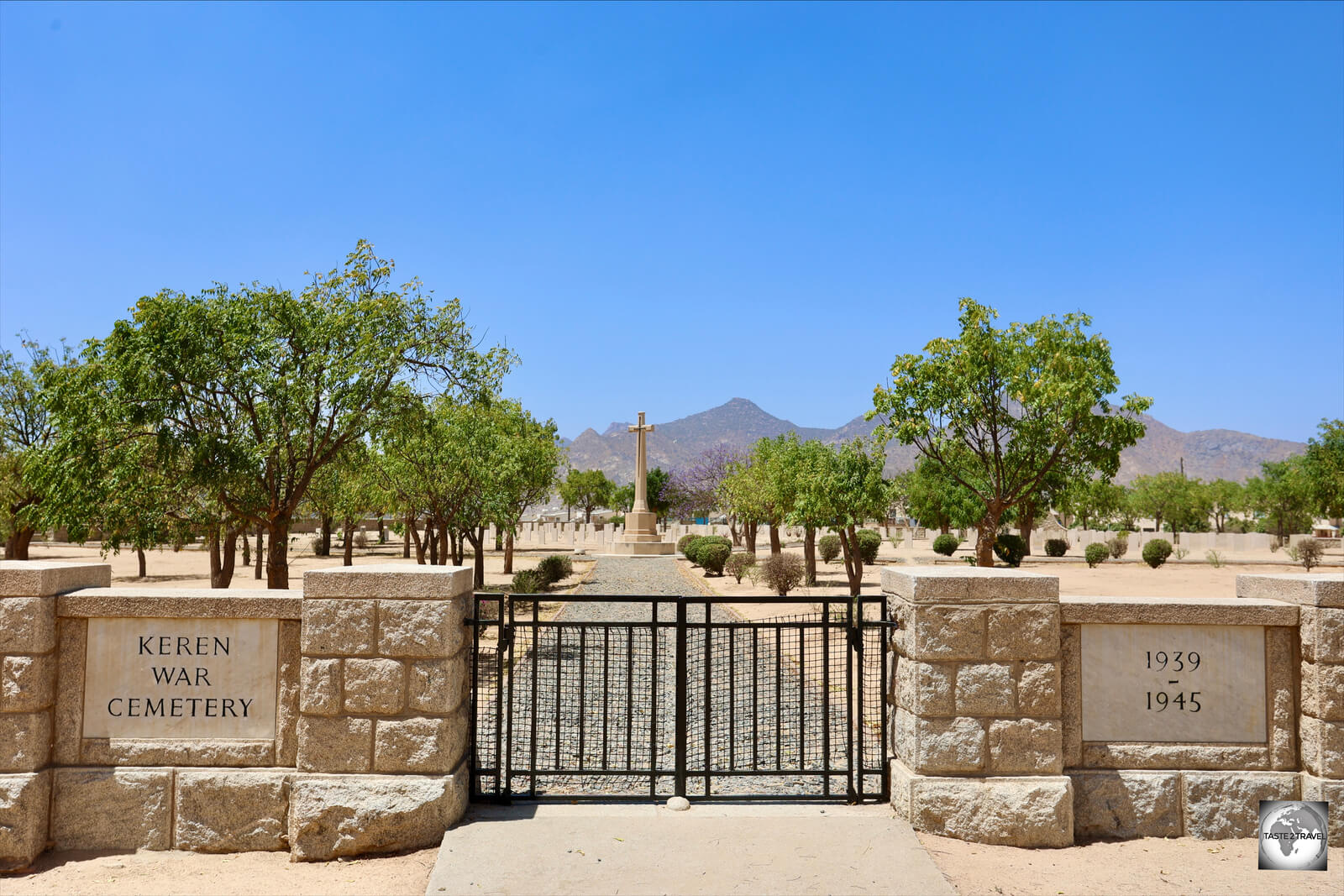
The entrance to the Commonwealth War Cemetery in Keren.
During World War II, Keren was the site of a major battle between the British and Italian forces in February-March 1941. The battle, which lasted for two weeks, resulted in a victory for the British and marked a turning point in the war in East Africa.
It was this victory which led to Italy surrendering all claims on Eritrea.

Memorial cross at the Commonwealth War cemetery in Keren.
Located on the outskirts of town, a perfectly maintained Commonwealth War Cemetery is the final resting place for British and Commonwealth forces who died during WWII in Keren.
The cemetery gate is normally closed but visitors are able to enter. The ground staff are very friendly and will be happy to show you around.
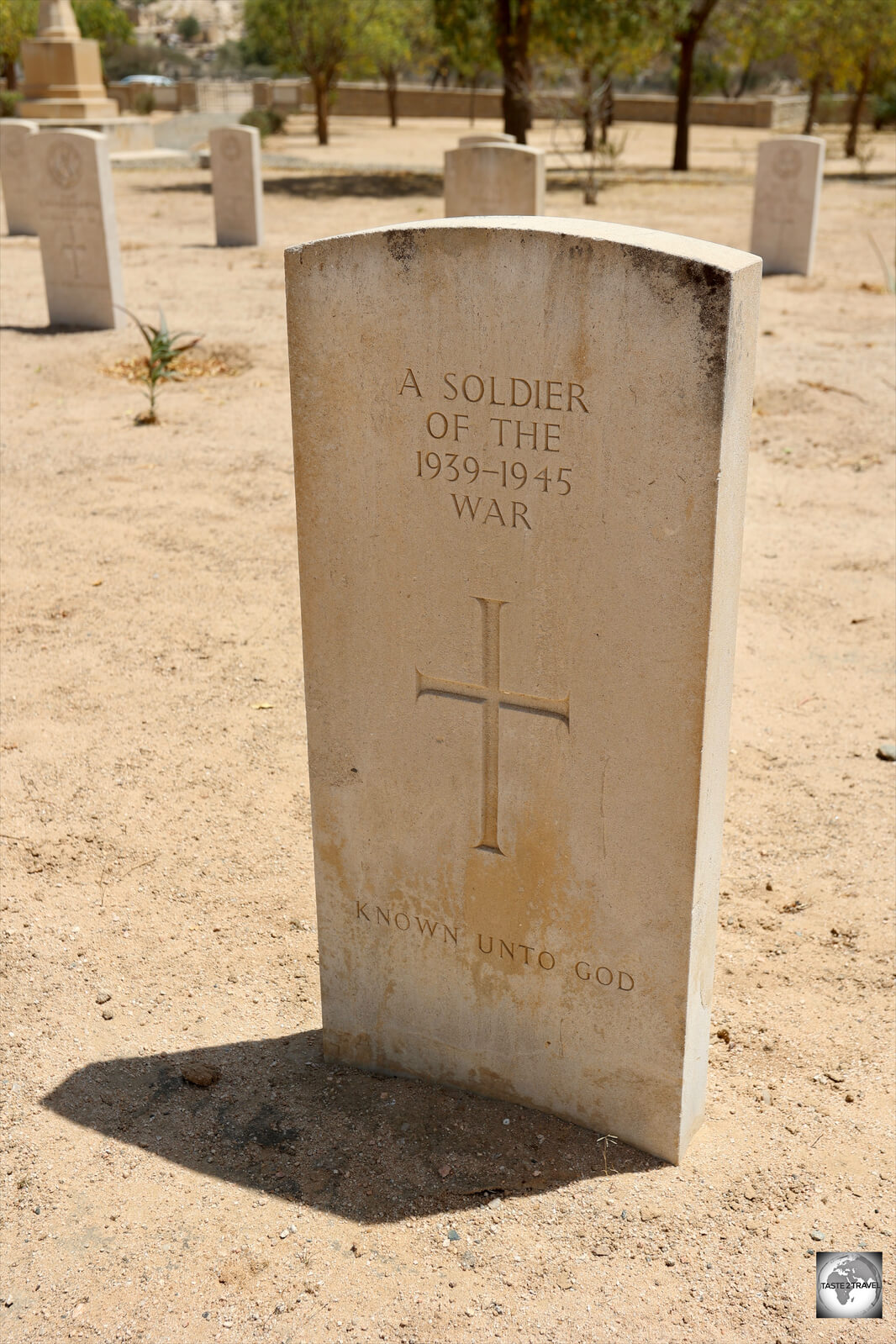
Gravestone at the Commonwealth war cemetery in Keren.
Mariam Dearit Shrine

The Mariam Dearit Shrine is built into the hollow of a large baobab tree.
Located on the outskirts of Keren, the Shrine of Mariam Dearit, also known as the Madonna of the Baobab, is situated in a naturally hollow trunk of a large baobab tree.

A view of the Mariam Dearit Shrine, inside the hollow of a baobab tree.
Said to be more than 500-years-old, this Catholic shrine is extremely popular with locals and visiting Eritreans, and there’s also a small chapel on site for ceremonies or prayers.

The Mariam Dearit Shrine, inside the baobab tree.
If coming from town, it would be best to come with your own transport or with a taxi. The shrine compound is located about 5km from town, in the most unlikely location. The taxi driver should wait for you!

Jacaranda trees line the highway between Keren and Asmara.
Qohaito

Ruins from the ancient city of Qohaito, which flourished in the 8th century BCE.
Located about 140km (2-hours) south-east of Asmara, close to the Ethiopian border, in the Debub region, Qohaito is an ancient city which dates back to the pre-Aksumite period, around the 8th century BCE.
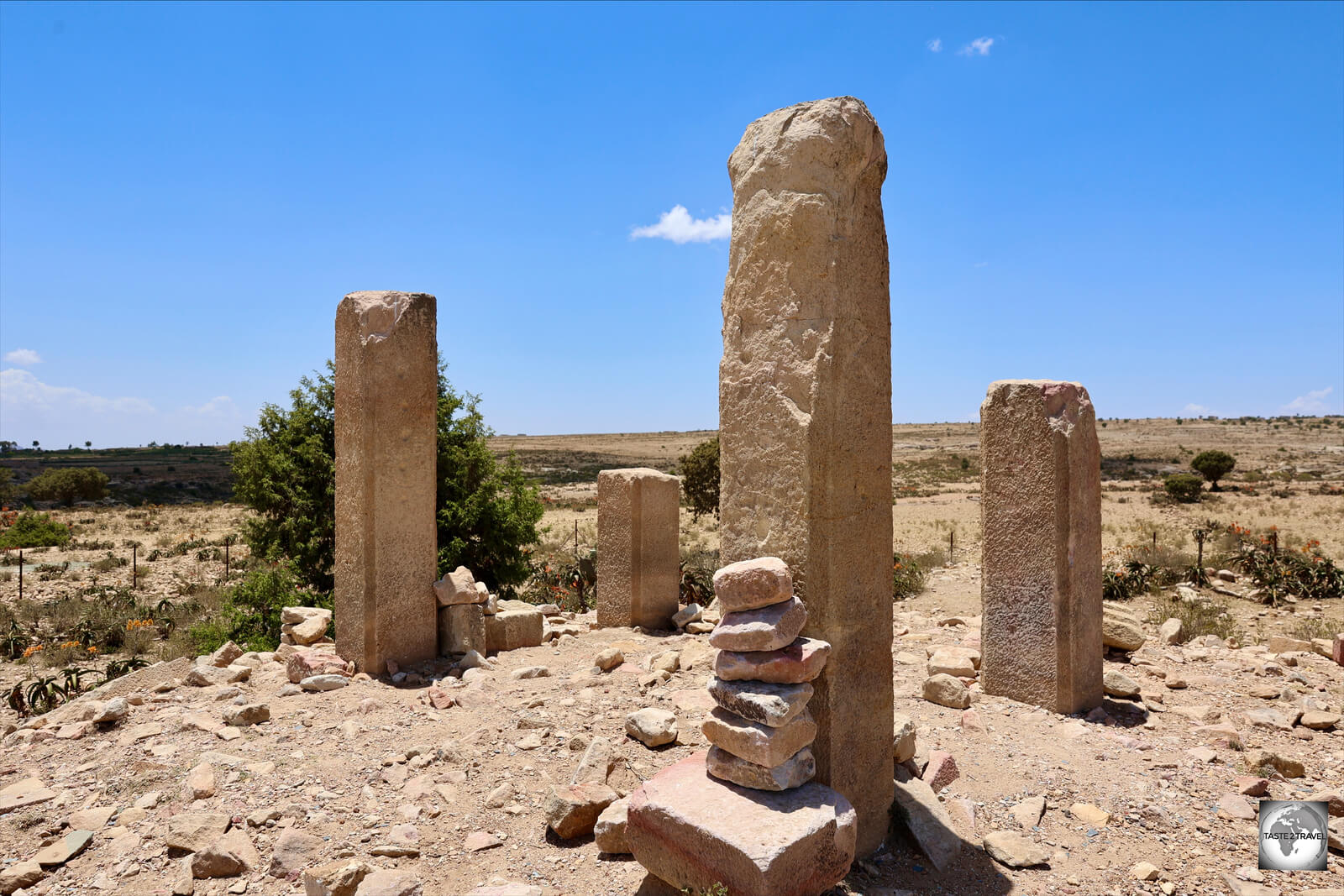
Temple ruins at Qohaito.
Qohaito was one of the largest and most powerful cities in the Horn of Africa during its heyday, and its ruins still bear witness to its past glory.
The city was built on a hill surrounded by fertile plains and was strategically located along major trade routes connecting the Red Sea coast to the interior of the African continent.

A track, used by ancient camel caravans, leads from the depths of Great Rift Valley up to the plateau.
Located at 2,500 metres above sea level, on a high plateau, at the edge of the Great Rift Valley, Qohaito lies directly to the west of the ancient Red Sea port of Adulis.

A sandstone-hewn, underground tomb, at Qohaito.
Qohaito, which in Saho means rock, has yet to be excavated or investigated by archaeologists.
In one place, our local guide bounced a boulder onto the ground. This made a hollow sound which indicated that an underground chamber lie below our feet.
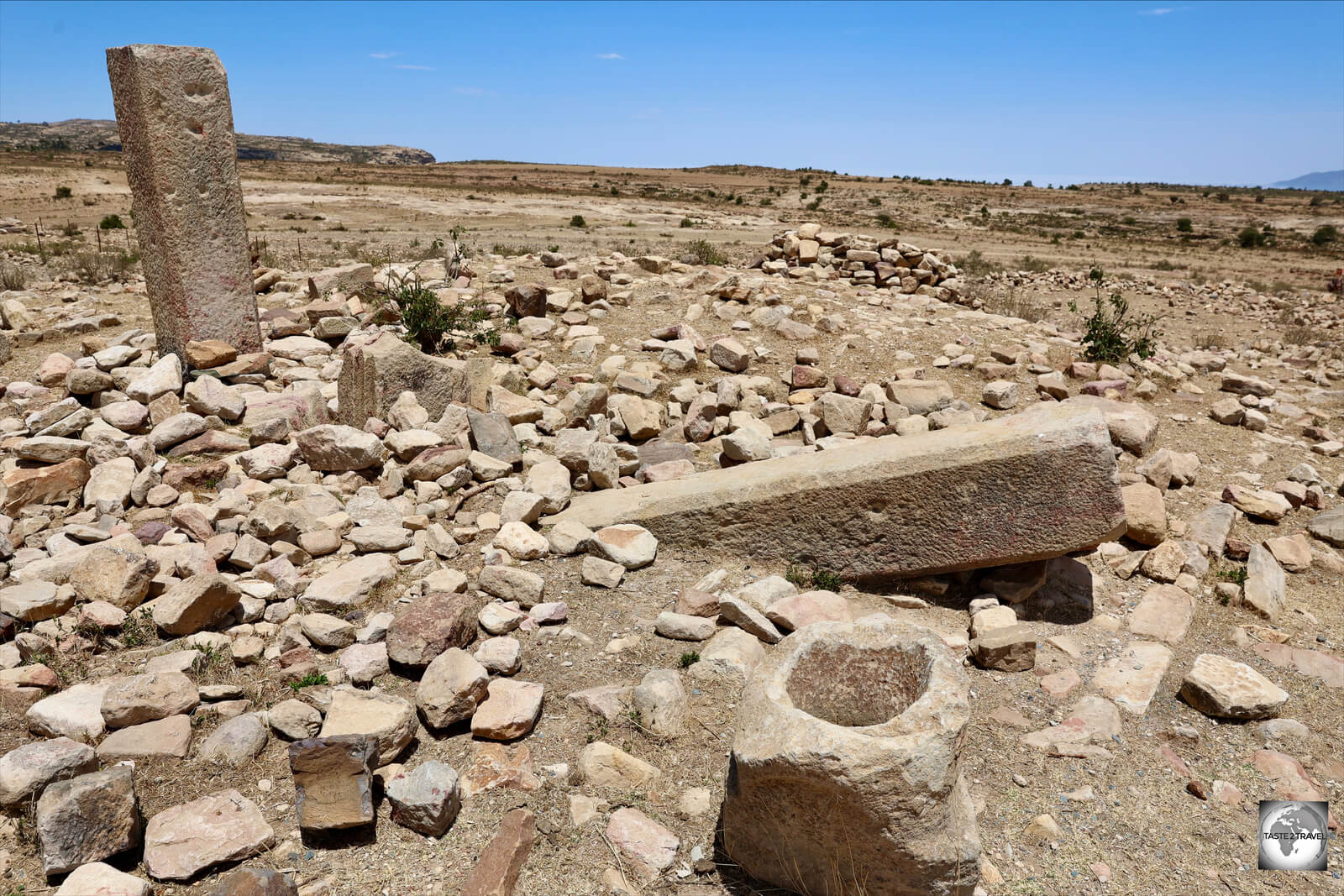
Carved stones from an ancient temple lie in wait, ready for archeological investigations.
Several stone structures, which are believed to be pre-Christian era temples, dot the landscape. An underground tomb, carved out of sandstone, awaits investigation.

Nothing is known about this tomb. The whole site is currently a mystery.
The area today is sparsely inhabited by a few villagers from the Saho and Tigrigna ethnic groups.

Stone columns, from a pre-Christian era temple, at Qohaito.
I drove to Qohaito with my guide and driver in a 4WD, which is required as the ruins lie about 20km off the main highway, at the end of a rough, unsealed, road.
It is impossible to reach this site using public transport.

A view of the Great Rift Valley from the plateau at Qohaito.
Once we arrived at a nearby village, we were required to pick up a mandatory government guide, who escorted us during our visit.

An ancient dam at Qohaito, which is said to be more than 2,500 years old.
The first site we visited was a dry dam which was built more than 2,500 years ago. The dam features the original basalt-stone walls which were used to retain water.

A view of the Great Rift Valley from the plateau at Qohaito.
From the dam, we drove to the edge of the plateau which affords the most stunning views of the Great Rift Valley, which lies 500 metres below.

From the Qohaito plateau, it’s a 500-metre drop into the Great Rift Valley.
Eating Out
Cuisine

The staple of Eritrean cuisine, Injera was always served for lunch.
Eritrean cuisine is a fusion of different cultures and influences, reflecting the country’s diverse history and location at the crossroads of Africa, the Middle East, and Europe. Some of the main components of Eritrean cuisine include:
- Injera: This is a sourdough flatbread that is a staple of Eritrean cuisine. It is made from teff flour and is served with a variety of stews and sauces.
- Tibs: This is a dish of sautéed meat, usually beef or lamb, with onions, garlic, and peppers. It can be served as a main course or as a side dish.
Overall, Eritrean cuisine is flavorful, aromatic, and often spicy. It incorporates a wide range of ingredients and flavors, making it a unique and exciting culinary experience.

Always eaten by hand, Injera is often served with a spicy goat stew.
Restaurants / Cafés
Asmara

Due to its Italian influence, cafés are numerous in Eritrea.
Asmara is home to many restaurants and cafés, with Italian staples such as pasta and pizza featuring on many restaurant menus.

Most cafés in Asmara, such as Bar Gianna, are wonderfully retro.
Like in neighbouring Ethiopia, coffee in Eritrea is served in short glasses, as a very strong Caffè macchiato.

A typically strong Caffè macchiato, served in a café in Asmara.
Keren

Friendly Eritreans, relaxing at the Sweet Corner café in the city of Keren.
The streets of the northern city of Keren are lined with large, shady trees. Establishments, such as the inviting Sweet Corner café, offer seating on the footpaths, underneath these trees, allowing locals to chill and relax on the street.

While in Keren, we spent time relaxing in the garden of this café, where we enjoyed sweet black tea.
Also in downtown Keren, the Ishbilia café offers a relaxed vibe in its small enclosed garden, where glasses of sweet black tea are served with glasses of Ariki.
Adi Keyh

The relaxing garden courtyard at the Milan Restaurant in Adi Keyh.
After the long drive from Asmara to Adi Keyh, we paused in the leafy and green garden at the Milan restaurant, where we enjoyed glasses of sweet black tea.

A male Ruppell’s Weaver, in the garden of the Milan Restaurant at Adi Keyh.
The garden was especially active with bird life, including a male Ruppell’s Weaver, which was clearly checking me out.

The interior of the Milan Restaurant in Adi Keyh.
Bars
Just as Italy, where cafés serve as bars and bars serve as cafes, so too in Eritrea, alcohol is freely available in any café.
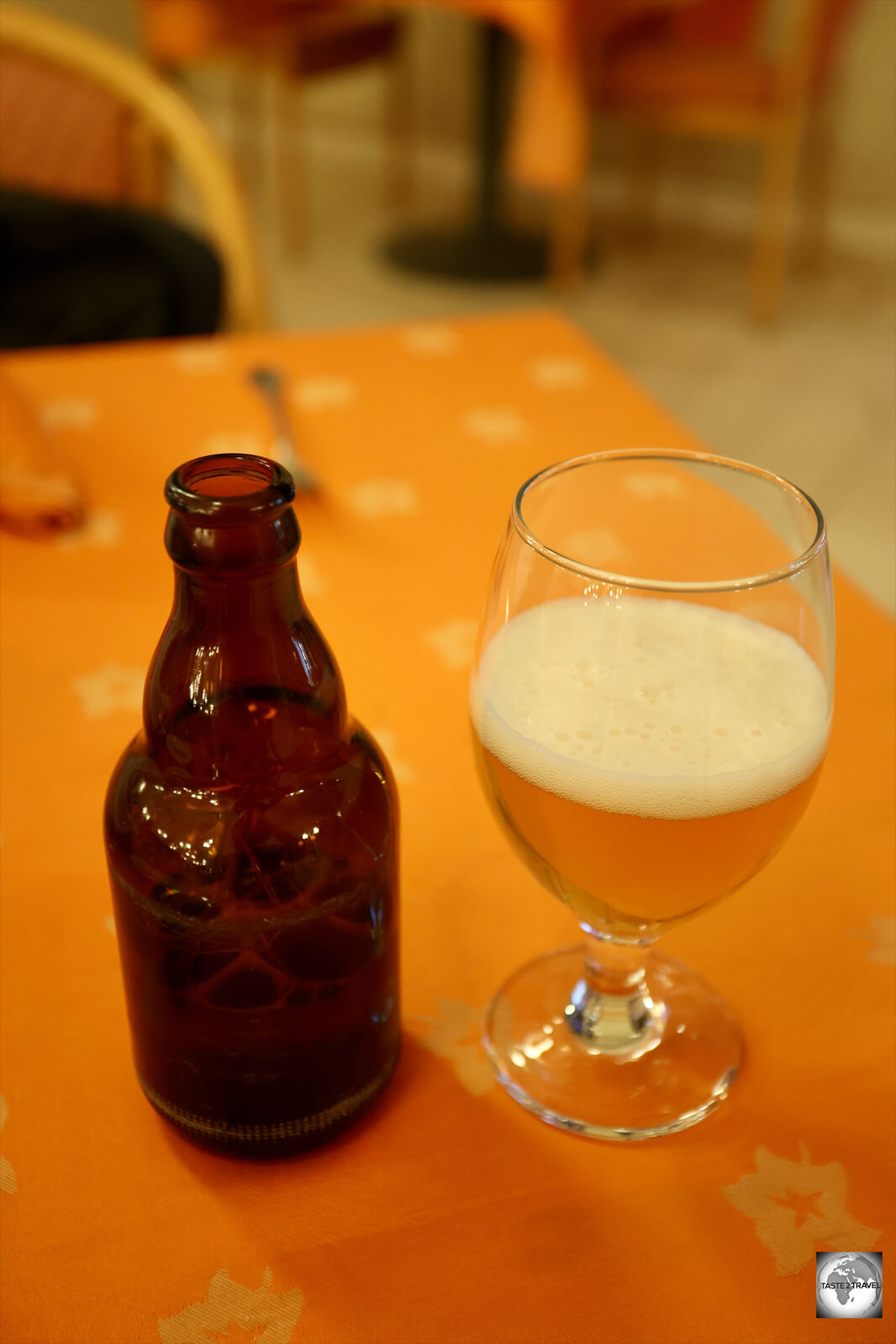
Within Eritrea, Asmara beer is always sold in a brown, unlabeled, bottle.
All alcohol is produced by the Asmara brewery who brew just one type of beer, a pale lager which is traditionally brewed using malted barley, hops and the purest of mountain water. It is a very smooth and highly quaffable beer.

However, exported Asmara beer is always labelled.
Within Eritrea, the beer is always sold in its distinctive brown bottle without any label. Labelled bottles are reserved for export with the beer being popular in Europe.

Asmara Brewery produces a range of popular alcoholic beverages.
Besides beer, Asmara brewery produces a range of alcoholic beverages including gin, cognac and Fernet-Branca.
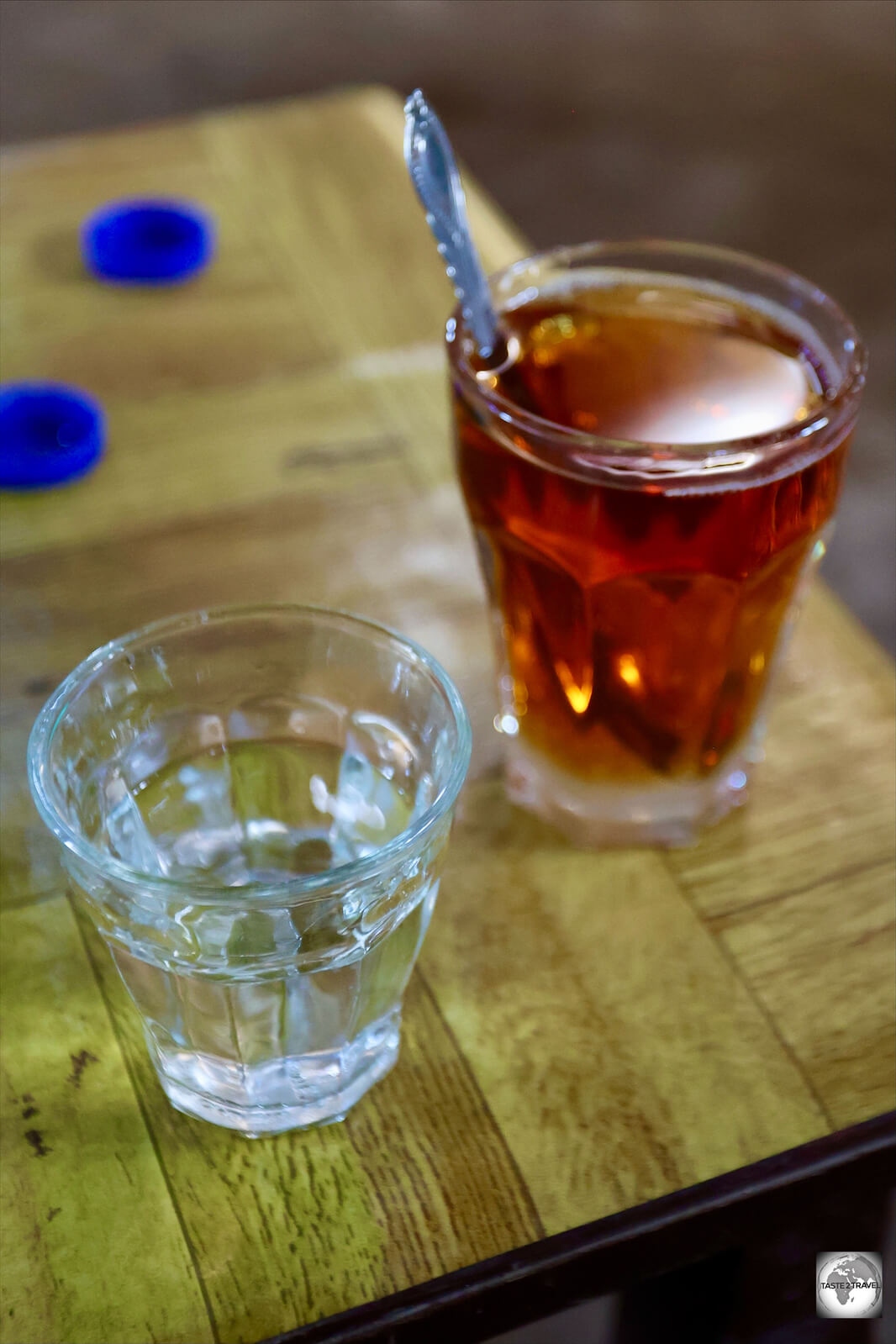
Drinking Ariki, and a tea, in a tea house in Massawa.
However, Asmara brewery is best known for producing Ariki, a very smooth, aniseed-flavored spirit. Very popular, Ariki is consumed on any occasion and is popular in tea houses as a side drink.

After sunset, outdoor bars/ restaurants open up along the corniche in Massawa old town.
While waiting to board my flight from Asmara to Addis Ababa, many Eritreans were buying up bottles of Ariki from the duty-free shop. A distinct aniseed aroma could be smelt throughout the airport waiting lounge.
Nightlife

Eritrean nightlife at a restaurant in the Asmara Expo grounds.
If you would like to experience Eritrean nightlife, you can do this is at a couple of restaurants/ nightclubs which are located inside the Asmara Expo grounds.
I attended one such restaurant with Captain Kahsai.
After dining on the finest Injera, we adjourned to a darkened room where local musicians were playing traditional musical instruments and the waitresses demonstrated traditional Eritrean dances.
Accommodation

My tour package included accommodation at the deluxe Asmara Palace Hotel, the best hotel in Eritrea.
Accommodation options in Eritrea vary from basic to luxury. There is something to suit every budget, although the budget hotels can be scary!
Since I was travelling on a tour, my hotels were included in my package. During my time in Eritrea, I stayed at the Asmara Palace hotel and the Grand Dahlak hotel in Massawa.
Asmara Palace Hotel

A view of my spacious and comfortable room at the Asmara Palace Hotel.
Asmara Palace Hotel is a luxurious hotel located in the heart of Asmara, a short, 5-minute, drive from Asmara International Airport.
This is the best accommodation option in Eritrea with rooms costing around US$120 per night. This includes a decent buffet breakfast – plus Wi-Fi (a real treat in Eritrea). My tour included 4 nights at the Asmara Palace hotel.

A view of the reception desk at the Asmara Palace Hotel.
The Asmara Palace hotel features 186 comfortable and spacious rooms and suites, each designed with comfort in mind. My bed was especially comfortable and enticing, but with a busy sightseeing schedule, I had little time to relax.

A view of the atrium at the Asmara Palace hotel.
The hotel is housed in a grand building that was originally constructed in the 1930s and has been renovated many times since.
The hotel offers modern amenities and good service, making it a popular destination for business travellers, tourists, and locals alike.
During my stay, I was the only tourist staying at the hotel. Most guests were in town on business, including a team from the UN.

To honour my stay, the Australian flag was flown outside the Asmara Palace hotel.
In honour of my visit, the Australian flag was flown outside the hotel – the 2nd time this has happened. The first time this happened was during my stay at a hotel in Mariehamn, the capital of the Åland Island.

The view, from the balcony of my room, which shows the glass enclosure of the indoor pool, the outdoor pool and the tennis courts in the rear.
Asmara Palace Hotel also offers a range of recreational facilities, including a large indoor swimming pool, an outdoor pool, a fitness centre, a spa and two tennis courts. The facilities seemed to be used more by visiting locals than by the guests themselves.
The hotel restaurant serves a variety of local and international cuisine, with the salads being especially good. Most fresh produce in Eritrea is served straight from local farms with vegetables and salads being crisp and full of flavour.

The Asmara Palace hotel offers the best accommodation in Eritrea.
Overall, Asmara Palace Hotel is a luxurious and elegant hotel that offers a unique blend of modern amenities and traditional charm.
I enjoyed my stay here and really didn’t want to leave!
Grand Dahlak Hotel

The entrance to the not-so-grand ‘Grand Dahlak Hotel’ in Massawa.
Despite its name, there is nothing ‘grand’ about the Grand Dahlak Hotel. This former grande dame might once have been a shiny beacon of hospitality, but its star faded long ago.

The lobby of the Grand Dahlak hotel.
A forlorn air hangs heavy over this hotel, with its lethargic staff wilting in the still, mid-day heat. The once grandiose reception area is now dusty and silent while the large swimming pool has been empty for years.

My less-than-appealing room at the Grand Dahlak hotel.
Upstairs, the rooms are old, tired and in need of a complete renovation.
In terms of comfort and hospitality, the Grand Dahlak hotel is at the opposite end of the spectrum to the Asmara Palace Hotel.

Outside the gates of the Grand Dahlak Hotel, the tree-lined streets of Massawa new town are eerily quiet.
Breakfast is served at an outdoor café next to the pool. Diners are fully at the mercy of a flock of ravenous black ravens who perch themselves at vantage points around the café, waiting for an opportunity to swoop and steal your breakfast.
One poor Italian man left his table for 1 minute to collect a cup of coffee. When he returned, his entire breakfast had been air-lifted away by a team of kamikaze ravens.
It was hilarious watching a raven trying to fly while holding onto a huge slice of toast bread and at the same time fending off attacks by his hungry mates.
Interestingly, the Italian hadn’t noticed anything was a-miss until he went to pick up his toast and realised everything was gone!

The empty pool at the Grand Dahlak Hotel in Massawa.
There is nothing inviting or enticing about the Grand Dahlak hotel and I was happy that I spent just one night there!
Sadly, the Grand Dahlak hotel is the best hotel in Massawa!
Visa Requirements

My Eritrean visa, which was issued upon arrival at Asmara International Airport.
Tricky! Almost all nationalities require a visa to enter Eritrea and they can be notoriously difficult to obtain if you apply through an embassy.
You can check your visa requirements by consulting the current Visa Policy of Eritrea.
I used the services of Damera Tours who secured a visa authorisation, without fuss, in 10 days.
It is important that you do not make any travel arrangements to Eritrea until you have first secured the visa authorisation.
Visa Application Process
The following steps describe the Eritrea visa application process:
- I first completed a Visa Application form which was emailed to me by Damera Tours.
- After waiting 10 days, I received a Visa Authorisation via email. The fee for this is included in the cost of the tour.
- Once I had the authorisation, I was then free to book a return flight to Asmara and confirm my tour arrangements with Damera tours.
- I printed the Visa Authorisation form and presented it to the immigration officer upon arrival at Asmara International airport.
- At the airport, I was handed a new visa application form which I had to complete.
- I was required to pay the visa fee of USD$70 (in cash) and provide a passport-size photo.
- After about 45 minutes, I received my passport with a tourist visa which was valid for a stay of 30 days.
Damera Tours Visa Service
The key benefit of using the services of Damera tours is that Captain Kahsai, who is well connected in Eritrea, takes care of your visa authorisation. He assured me that he has a good success rate!
As part of the visa process, Damera tours emailed me a visa application form, which I completed and returned.
After a period of 10 days, I received my visa authorisation form.
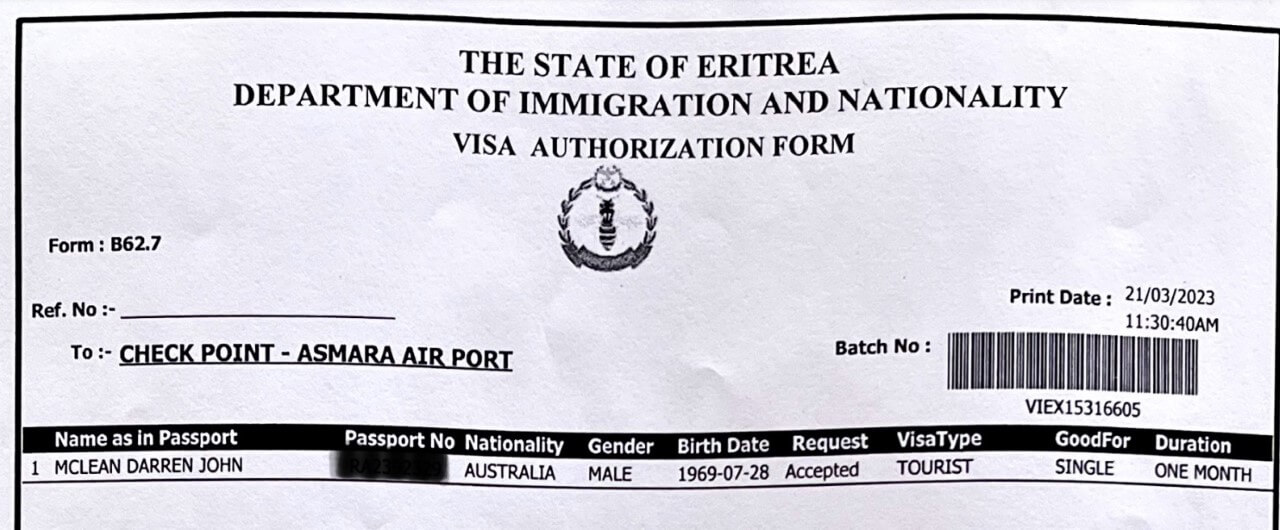
My Eritrean Visa authorisation form, which I received via email.
Pictured above, the visa authorisation (fee included in the cost of your tour) simply allows you board a flight to Asmara.
Upon arrival at Asmara International airport, you will be handed a fresh application form which needs to be completed and submitted, along with one photo and US$70 in cash. You will then be issued with a full-page sticker visa in your passport, valid for a stay of 30 days.
In order to use the visa service of Damera tours, you will need to book a tour. Captain Kahsai can tailor a tour to suit your needs with tours starting at just 3 days.
The average cost of a tour is US$200 per day, which includes everything, except meals and personal expenses.
Important Tip:
Once you have completed your tour, you are free to remain in Eritrea and travel independently.
A tourist visa is valid for a stay of 30 days.

Two identical visa receipts, which total US$70.
Note for US Passport Holders:
While in Eritrea, I was told that the visa rejection rate for US passport holders is quite high.
This is due to the fact that the United States government imposed sanctions on the Eritrean government in November of 2021 due to its role in the Tigray War in neighbouring Ethiopia.
If you are a US citizen, who is fortunate enough to own a 2nd passport, you should apply for an Eritrean visa using your non-US passport.
Getting There
Air
With all land borders closed, the only way to enter Eritrea is by flying into Asmara International Airport (IATA: ASM), the only airport in Eritrea.
With Eritrean Airlines currently grounded due to safety issues, Ethiopian Airlines are currently the de-facto airline of Eritrea, operating 17 flights per week between Addis Ababa and Asmara.
Included in the hefty ticket price is a ‘fee’ which Ethiopian airlines pay to the Eritrean government for the privilege of flying 17 times per week.
A standard return ticket between Addis and Asmara can cost up to US$500 for the 90-minute flight!
The following airlines provide scheduled flights to/ from Asmara:
- EgyptAir – flies to/ from Cairo
- Ethiopian Airlines – flies to/ from Addis Ababa
- flydubai – flies to/ from Dubai–International
- Tarco Aviation – flies to/ from Khartoum
- Turkish Airlines – flies to/ from Istanbul
Airport Transport
The Asmara Palace hotel sends a shuttle bus to meet all incoming flights. If you are staying at the hotel, airport transfers are free. It’s a 5-minute drive from the airport to the hotel.
Yellow city taxis can also be found outside the airport. The fare should be negotiated before you commence your journey!
Land
Despite sharing land borders with Sudan, Ethiopia and Djibouti, all land borders are currently closed to tourists.
Sea
No scheduled passenger ships arrive at Massawa port.
Getting Around

An Italian-built bridge on the highway from Asmara to Massawa.
Much of the infrastructure which exists in Eritrea today was built by the Italians during their occupation of the country from 1882 to 1941.

An out-of-use railway viaduct lies alongside the Asmara to Massawa highway.
The Italian-built highway, which connects Asmara to the Red Sea coast at Massawa, follows alongside the Italian-built rail line, which has been closed for many years.

The Asmara to Massawa highway is congested with slow-moving trucks which haul goods up and down the mountains.
The highway which links the country’s capital to its only port is congested with trucks which haul goods up and down the mountains.
Many of the trucks (including two pictured above) carry locked containers which contain raw gold ore. While there are many gold mines in Eritrea, there is no smelter facility for processing the raw ore.
The only way to process the raw ore is to have a fleet of trucks haul the ore down to the port, where it is exported for processing.

A view of the Asmara to Massawa highway, as it crosses the coastal plain near Massawa.

The mandatory ‘travel permit’ is issued at this Tourist Information office in downtown Asmara.
Important:
Eritrea presents plenty of obstacles for the traveller. One such obstacle is the Travel Permit.
In order to travel outside of Asmara, you will need to apply for a travel permit. Without this permit, you will not get far and will be forced to return to Asmara.
The permit is issued at the Tourist Information office in downtown Asmara. You will need to present your passport and in return you’ll be issued with a travel permit.
You should ensure you make many photocopies of this permit as a copy can be requested, and retained, at the many highway checkpoints.
A benefit of travelling with Damera Tours was that they took care of the permit for me and they managed the checks at the various checkpoints. I would guess that in a week of travelling, they handed out a dozen copies of my travel permit.
In the town of Adi Keyh, the administrative centre for the Debub region, we stopped outside a non-descript building and waited while my guide submitted a copy of my travel permit to an official inside the building. Who would have known that was a requirement?
Bicycles

Cycling is the biggest sport in Eritrea, and its cyclists are the best in Africa – and increasingly among the best in the world.
A legacy of the Italian occupation, bicycles are the most popular form of transport in Eritrea. Like China 30 years ago, the streets of Asmara are full of people riding their bicycles.

Eritreans became fascinated with the sport of cycling when they watched Italian cyclists racing in the streets in the 1930s when their country was an Italian colony.
Apart from recreational riding, the sport of cycling is the #1 sport in Eritrea.
Due to its mountainous terrain, the highways in the countryside are the perfect place for racing teams to hone their skills and improve their endurance.
While travelling on the road from Asmara, down to Massawa, we passed dozens of teams racing up and down the mountains.
Bus

Public buses connect Asmara with all towns in Eritrea.
Inter-city buses connect Asmara with all major towns. Buses depart when full.
Taxi

Ubiquitous yellow taxis can be found everywhere in Asmara.
Yellow taxis are plentiful and everywhere.
Fares should be negotiated in advance!
Train
There are currently no trains operating in Eritrea.
Rental Cars
While there are a few rental car companies in Eritrea, including at the Asmara Palace Hotel, tourists are currently unable to rent cars by themselves. You can however rent a car with a driver!
That’s the end of my travel guide for Eritrea. If you have any comments or feedback, please contact me using the comment form below.
Safe Travels!
Darren
Further Reading
You might be interested in reading my:
Author: Darren McLean
Darren McLean is an Australian, full-time, digital nomad who has spent 37 years on a slow meander around the globe, visiting all seven continents, 192/ 193 UN countries and 245/ 251 UN+ countries and territories.
He founded taste2travel to pique one’s curiosity and inspire wanderlust.







